FIELD NOTES






A LOOK INSIDE:
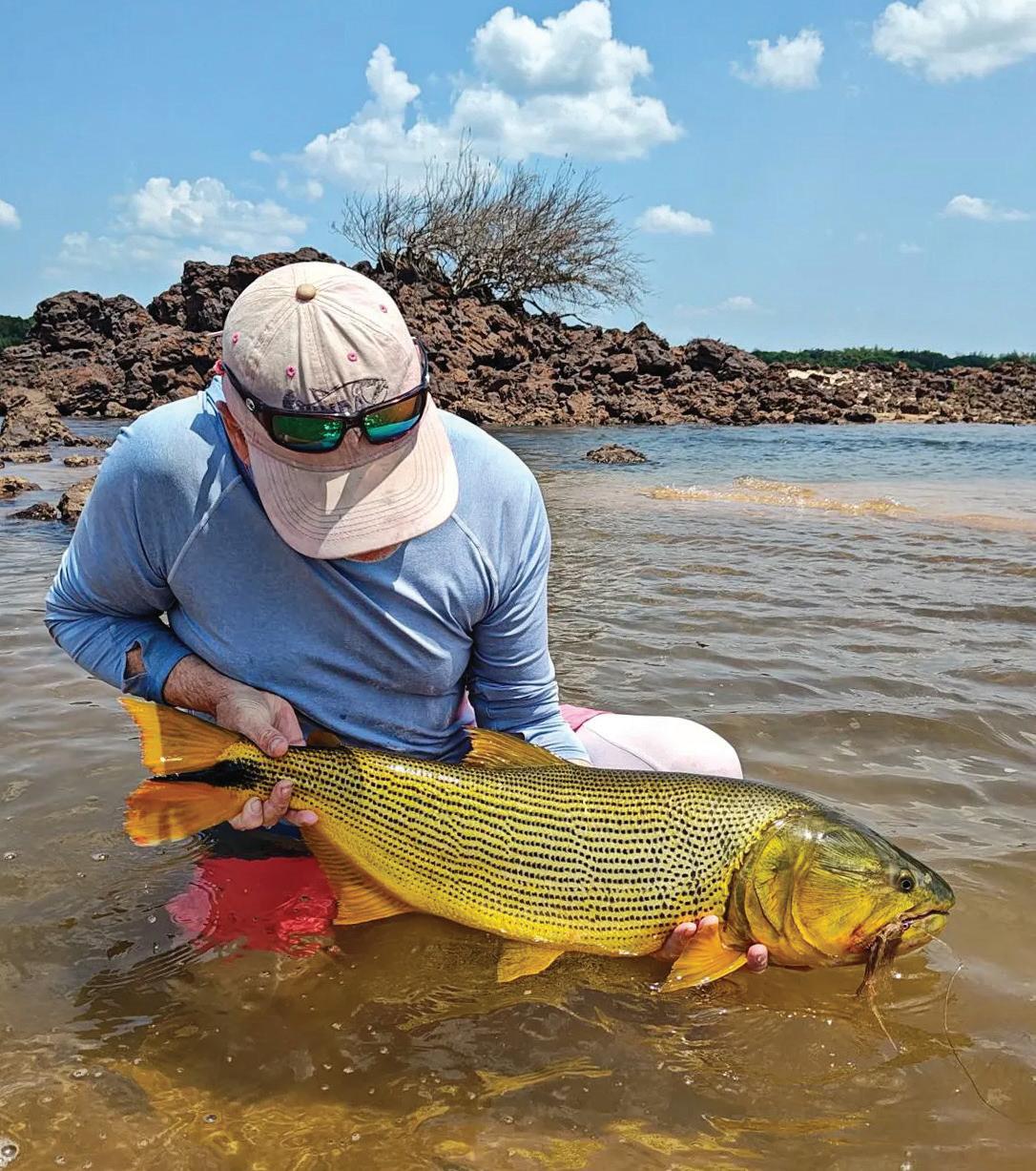








A LOOK INSIDE:


Prime time for fishing for large brown trout during the baitfish run 21st to 28th June 2026
2 rods remain at €6,580 for single room/shared guide.
Prime time for the run of multi-sea-winter fish on the East Ranga Iceland 11th to 15th July 2026
6 rods at £8,650 single room/shared guide.
An excellent tide for Providence Atoll, perhaps the most productive and reliable fishing in the Seychelles - 7th to 14th December 2027
4 rods available at $16,950 shared room/shared guide.
This is one of our most reliable trips with a combination of good fishing and superb hospitality. 14th - 21st November 2026. The trip is priced at $5825 per person for 7 nights single accommodation on a full board basis and 6 days fishing with a shared guide and boat.

BY TARQUIN MILLINGTON-DRAKE

Hafralonsá has always intrigued me and indeed is an intriguing river. To my mind it has always been cast (wrongly in my view) by those who have fished it in year’s gone by as ‘a man’s river’ requiring a robust approach for ‘real men fishers’ and if one did not fit into such a category, one should not bother to consider fishing it and one was clearly not a truly hard-core salmon fisher. Then came ‘the influencer’ era which had the same connotations – this river is reserved exclusively for the hard men of the salmon fishing world – big fish – lots of skill and real manliness required.
During more recent years, the river has been in the hands of various leaseholders for short periods, and one had the sense it was being fought over but equally being passed around and not finding a true home. Too often in Iceland leases are so short that the leaseholder lacks the inclination to invest and look after a river – the policy is more likely to be make

money as fast as possible. In summary, even I was a little fearful of the whispered word Hafralonsá and wondered if I was going to be up to it. You can imagine my surprise (admittedly in a low water year) when I found myself happily fishing a 6 weight (and even 4 weight), single-handed rod covering the pools with ease. Though I would agree that perhaps a 7 weight, a switch and maybe a 12ft rod would be the perfect armoury for all heights of water. Let me expand.
The first signs that there was more to the Hafralonsá than machismo was when I started chatting to guides who I consider friends. They all went gooey with me when I said I was headed to the Hafralonsá. These guys are guides who might be your guides on the river and whom I truly respect as salmon fishing guides. The gentle Stebbi, who guides the great and the good on Sela, almost had tears in his eyes as he told me about landing his first ever Atlantic salmon on
the fly on Hafralonsá as a teenager. The brainiest, thinking-est salmon guide I know, Sigthor, went all weak at the knees as he told me with his characteristic gentle, soft voice, ‘you will really like it’ with a dazed, jealous tone. Land speed record holder for fastest driver on the bumpy Hafralonsá roads (when alone in the car) Angus, who has fished the Hafralonsá since he was 12, goes all stary eyed and romantic (rare for him) as he reminisces about his days on Hafralonsá. His affection for Maggie, a river-owner, farmer and cook at the lodge is also charming and a testament to his many happy days on the river.
Finally, the dashing, debonair Hugo with whom I work almost daily tells me with a sparkle in his eyes that he always takes the opening days on the river… loyalty his girlfriend must dream about! These guys are not macho, egotistical men lacking substance or skill to back up their reputations, these are some of Iceland’s

best, hand-picked and lured to the northeast to create the finest guide team ever assembled in Iceland and I truly respect them. Their opinions and confidence that I would fall in love with Hafralonsá helped put my concerns about my manliness at ease.
The organisation that did the assembling of this talented guide team (and there are many others that are also part of the team) is the Six Rivers Foundation – in their own words – a not-for-profit conservation programme, which seeks to reverse the decline of Atlantic salmon.
The Hafralonsá has, in my view, found its natural home where it will be properly cared for and its restoration can begin in earnest and has the time to weather the naturally induced, peaks and valleys that any salmon river endures. The first decision made for Hafralonsá was a very good one – a reduction from 6 rods to 4 – and in my view, 3 or even 2 rods would be even better but luxurious on this 28 kms river with 55 names pools plus three others 0, 00 and 000 – all of which can be great so really 58 pools! The second was to close the tributary, the Kverka, allowing those salmon complete peace.
Hafralonsá is also blessed to be one of the Six Rivers (Sela, Hofsa, its tributary the Sunnudalsa, the Mio, Vesturdalsa and Hafralonsá) subject to the same rules as all the others. These are certainly the most enlightened rules within Icelandic salmon river management and probably across the whole Atlantic salmon platform. They are
No weighted flies
No sink or sink-tip lines
No hooks bigger than size 12
Two fishing sessions per day of no longer than 4 hours per session
No more than 2 fish from any pool in one session
Not more than four fish per rod per session
Full catch and release of all species
Any dead/bleeding fish should be returned to the lodge’s kitchen.
What these rules achieve is as follows:
Less fishing pressure but great fishing for everyone
Less impact on the fish
Better fishing for everyone through the season due to less pressure of weighed or bigger flies
Avoids excess when the opportunity to catch big numbers of fish arises
A more balanced season for all
No ‘damage’ to pool for the next guest who may fish it due to too many fish being caught or the way in which the fish were fished for
No incentive to kill fish in the hope of taking it home by calling it ‘a bleeder’
My only footnote to the rules is that Hafralonsá generally has colder water than the other rivers so at times, the no weight rules might be a little more of a handicap. The good news however is that the cold means a superb run of arctic char up to and over 6lbs and plenty of them catchable on dry fly as well as salmon flies etc.
These rivers also benefit from the most forward-thinking Atlantic salmon conservation effort in Iceland which includes tagging on all rivers, radio tagging and tracking on some of them, relocation of fish in the autumn to spawn in tributaries to open up the expanse of water available to the salmon, a massive tree-planting project to enhance biomatter in the rivers to, in turn, enhance food in the river, predator control with the focus on the non-indigenous mink. As a consequence, and the affection this river garners from so many, I have high hopes for this river.

The river currently has its old lodge which Six River has made perfectly respectable. It is a little tired looking from the outside and some windows could do with some attention, but it is bright and clean inside. It has six comfortable bedrooms, including four double rooms that share two bathrooms, and two double rooms with en-suite bathrooms. There is a large open-plan kitchen/sitting area and there are three options for catering – selfcatering, the wonderful Maggie that I have mentioned cooking, or the gourmet option. The lodge has stunning panoramic views of the river as it bends round the lodge.
There is a real bonus with HUGE potential too which would make Hafralonsá unique – overlooking the stunning Pool 35 or Stekkjarhylur (which incidentally fishes from the other side and has a nice tail where I hooked three fish!) is a large fishing hut which I pray Six Rivers restores and makes it really comfortable. At present it can be used but the furniture is old (which admittedly is perfect for sitting on with waders) but I envisage going up to the upper part of the river for the day, fishing the morning session, then coming back to the cabin, having lunch and a nap in a comfortable (warm if need be) bed before going out again for the evening session and returning home for dinner. Based on four rods, two could do this on one of the full days of the threeday programme and two the other day. If you were two rods – just one upriver and one down. If you were three rods, one on the lower, one on the middle and one on the upper. There is plenty of water! This cabin really would/does make for a special situation. Maybe one day rods could overnight there reminiscent of the Alaskan outpost camps? In summary, for
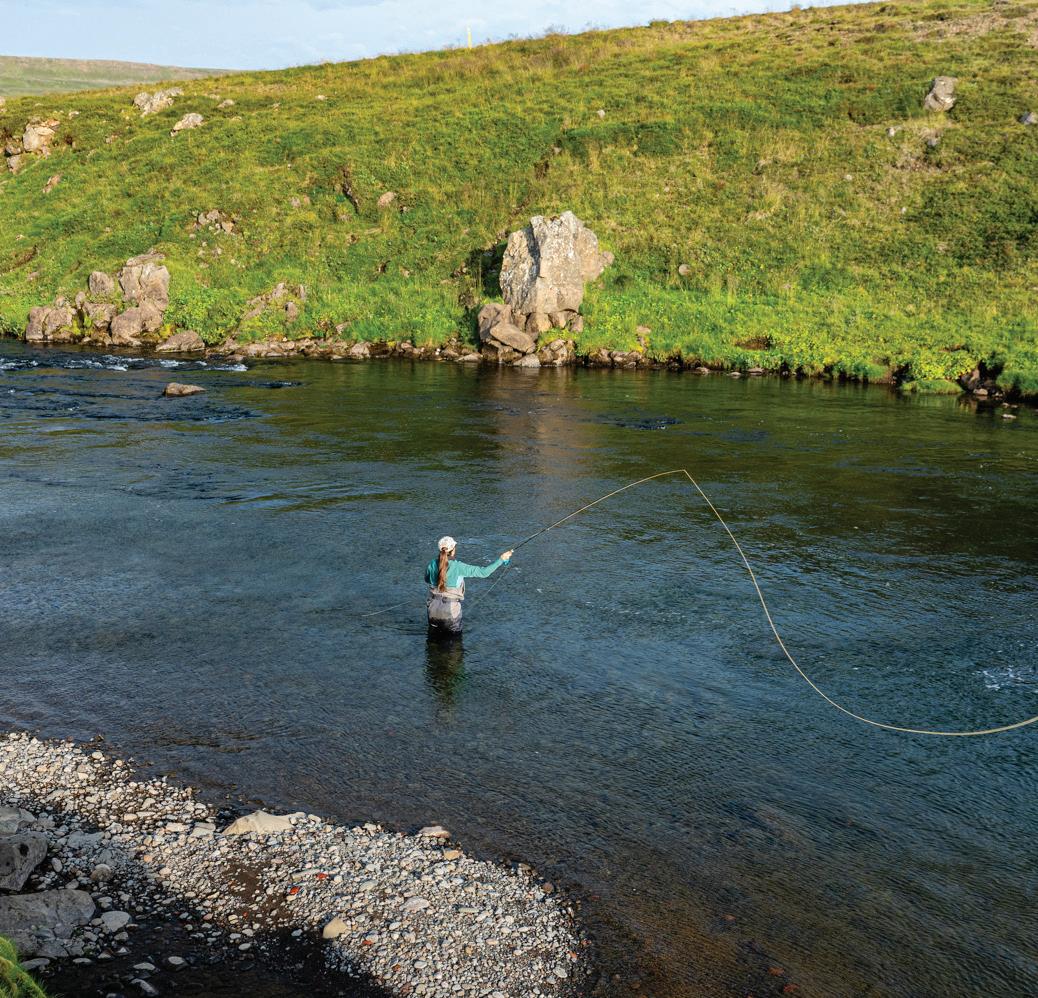
2026 (this piece is written autumn 2025) there is a perfectly nice and comfortable accommodation option. For 2027, potentially, the new lodge will be ready –there are some artist impressions of the lodge below and I refer you to my piece on the Mio here to see the standards to which that lodge has been built.
I need to come back to the river itself, to those misty-eyed guides whose affection for the river was so palpable. I note that even the river’s own website makes comments like “Untamed, harsh, remote… Explore the wild and rugged Hafralonsá and… best suited to those who are fit and adventurous”. I am afraid I think these descriptions are a little harsh or misleading so let’s look at the facts:
Pools 000 to 16 are either ‘get out of the car and fish’ pools or a short walk into a mild canyon with a perfectly walkable return to the car of a five-minute walk with an incline of perhaps 10 to 20 metres from getting out of the river to the height at which the car is parked. Numerically it is likely half and half and some pools like
14, 15 and 16 are all fished via the same walk in and out, so you get three prime, easily fished, pools for the price of one walk.
Pools 17 to 25 – 9 pools to be precise – are in the famous Hafralonsá canyon. Some are actually an easy walk down, some are a joke (two that I saw of the 9) and I would not go there and two have some metal stairs in very good repair which are a long way up and down, but the stairs make it infinitely easier. Personally, I think the photo of someone clinging to a rope is misleading, there are two pools with ropes and the one I saw was a joke and if I was guiding, I would not allow guests to
try and go down unless they were serious genuine army or mountaineering types!
Pools 26 upwards are a mix of ‘pull up to the pool in the car’ pools to some clambering up and down but nothing like the few pools in the deep canyon. I have fished Sela for 30+ years and can honestly say that the worst of Hafralonsá is child’s play compared to some of Sela. There is a walk from pool 50 to the top pool 55 (the breath-taking Lax Foss and final barrier), the guide said it was 20 minutes, and he was likely right all the way to the top but there are some truly stunning and interesting pools in between. I feel I need to qualify my comments and reveal
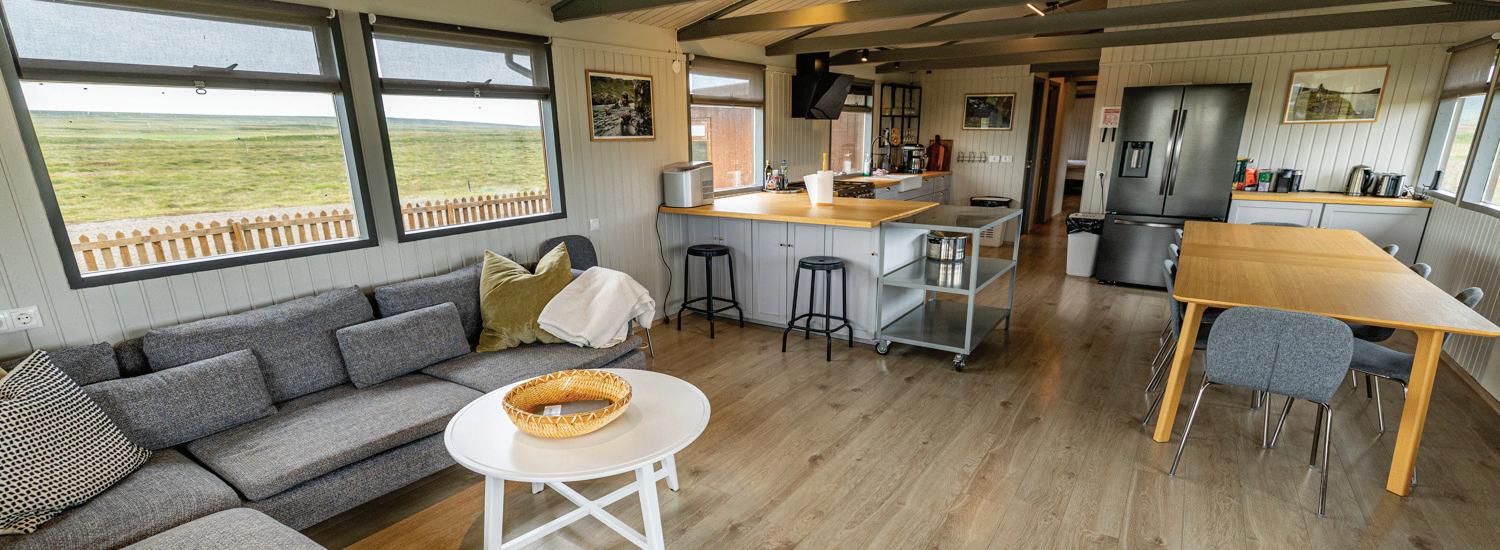

my age and stage – I am 60 at the time of writing – I do not believe that any of my guide friends would describe me as lythe and a fit stick insect yomping up and down the canyons in peak condition though I was a sportsman in my day – First XI Football, The Field and all that!
Most rivers in Iceland are untamed and certainly pretty much all those in the northeast of Iceland are – they all disappear into the hinterland of the interior of Iceland where only pink-footed geese, arctic foxes and reindeer hang out along with ancient wild trout and freshwater arctic char. Untamed is their appeal.
By their very nature – the majority of rivers in Iceland are harsh because they are very rocky and Hafralonsá is no exception.
Happily, the Hafralonsá, and its sister rivers, are all remote, wild and rugged – it is why they are so good and why we love them. It is why so many birds thrive unmolested by man or beast and in the case of the Six Rivers Foundation, a much-reduced threat from mink. I am hesitant to repeat myself but when it comes to remote, a night in that cabin would be amazing!
These words are all assets to the river, not something to fear or be wary of especially with the calibre of guides looking after you.
So why have I joined the ranks of my guide friends in having a soft spot for Hafralonsá? I have not mentioned the all-important calibre of the water we fish and the pools themselves. The water itself is ultra-clear so spotting the fish (which the guides do frequently) is easy, at least for the guides!
There was one pool which was awkward to fish – it is a named pool, but it is really a spot and a whacky one at that. You fish the top part having clambered down a way and the bottom part from the bottom of the pool upstream. I am not saying I did not enjoy fishing it, but it was the only one that was not mouth-watering and a delight to fish.
The best way to sum up the pools on Hafralonsá is to take a comment made by the brainy Sigthor, a man of few words but when he speaks it is sure worth listening to. We were actually on the Sela and discussing the rule of having to leave the pool after catching two fish and I commented how I was entirely content to leave the pool having caught a couple of fish. His classic Sigthor response was “that is because you are going to another equally stunning pool” and he would be right and that certainly applies to Hafralonsá every bit as much as Sela. The only difference for me is I know the Sela pools intimately. This is the reason they all so love the river, it is truly beautiful water and finally there is the fish themselves…


Hafralonsá is rightfully known for its bigger fish. I am not talking Norwegian big, but I am saying that it is perfectly reasonable to expect a high percentage of your fish to be in the teens with the possibility of 20lbs fish. You are not going to have a bonanza, but you will get seriously aggressive takes from some good-sized fish taking the small, classic Icelandic patterns (the hitch works extremely well) which will take off down the river with you in hot pursuit or, as one of my fishing partners experienced, have the fish charge up the pool and go round a big rock, then back down the length of the pool, weave you round another rock and then snap you off before you even know what is happening!
To conclude, I am as excited for the Hafralonsá and its future as I am about fishing the river. My whole experience
was a pleasure from start to finish – the lodge, its views, the pools, the aggressive nature of the fish, that special day using the cabin, the wildness, remoteness –everything. At two rods, the river is going to be very special indeed, at four it is going to be great value.
This river is in very good hands now and it should have a bright future – it is not for the old like the majority of rivers in Iceland but if you wish to embark on a romance or long-term relationship with a river with an excellent chance of a great future and have privacy, only sharing your river with friends and family, there probably is no better bet than the Hafralonsá at present.
To come back to Harmony with Hafralonsá – I was truly in balance, agreement, and peaceful coexistence within myself and my surroundings.
Tarquin Millington-Drake Director of UK Frontiers Travel Ltd

It is always exciting to have the opportunity to visit and fish a river for the first time, particularly a well-known and highly regarded river in Iceland which is operated and managed by old friends.
Earlier this month I made a last-minute trip to fish the East Ranga. I spoke my friends a few days before I left home and it seemed the river conditions were good with mild weather for mid-August in Iceland expected. All boded well for the trip!
East Ranga is situated in the south-west of Iceland, about a two-hour drive to the east of Keflavik Airport or just over an hour from Reykjavik. This makes it very accessible; I flew that morning from Heathrow and was at the lodge in time for lunch. Guests stay in the Aurora Lodge which is in a beautiful valley with views of Mount Hekla. My initial impression on arrival was of a very slick operation with a newly renovated and stylish lodge. The main building includes a spacious dining room with an open kitchen, then a separate bar that actually felt like a proper bar with a full range of drinks and then various other seating areas that allowed you to take in the views in comfort depending on the time of day. There is also a small tackle shop in the main building. The bedrooms are separate from the main lodge, in a series of smaller buildings opposite. The thoughtfully renovated interiors feel warm and comfortable with plenty of small touches that raised the level from an average fishing lodge room. I was pleased to see a coffee machine and the bathroom had plenty of hot, high-pressure water in the shower, both essentials for me on a fishing trip in a cold country!

WRITTEN AFTER 2024 SEASON - HOSTED TRIP FOR 2026
East Ranga is slightly different from many other Icelandic rivers. Due to the low water temperatures and the volcanic sand which makes up the riverbed natural spawning is not generally very successful. This has led to a smolt release programme that ensures a healthy run of both grilse and large multi sea winter fish each season. Fish run into the river from late June and all the fish we caught in mid-August were still silver with a few sea-liced. There is
no difference from a fishing point of view, these fish have made the migration that all salmon from Iceland do and return to the river as hard fighting beautiful fish that take a fly readily.
The river itself is also not a typical Icelandic river, although the landscape it flows through is quintessential Iceland. It is actually fascinating with each beat quite different, and many had the

characteristics of pools I had fished in rivers as far apart as Russia and Tierra del Fuego. The medium-sized river is best fished with a double handed rod or switch rod using one of the shooting head systems that allow you to change sink tips of different densities. Flies tend to be a little larger than those used on other Icelandic rivers I have fished and tend to be fished a little deeper, which is due to the colder water. The pools and beats have a lot of variety so it is necessary to think about your fishing, but the guide team is so good that you will always have good advice on how to approach any pool. Wading is quite straightforward with an easy bottom although sometimes deep wading is required. For those of you who miss Ponoi and like that style of fishing the East Ranga would suit you perfectly, for the fishing, the guides (many from Ponoi) and the lodge atmosphere.
Although I was fortunate to fish when the conditions were good, I was really pleased to land fish during nearly every session and some sessions rewarded us with multiple hook-ups. It was exciting fishing despite the fish not being super aggressive, partly down to the cold water. However, there were enough fish eager to investigate and it seemed that if you were patient you would be rewarded with fish when I was there. One aspect of the operation that I really enjoyed was the super experienced and international guide team. There were guides from Iceland, Scotland, Argentina, England, Ireland and South Africa. All were friendly, approachable and are going to add to anyone’s experience on the river, beginner and experienced fisher alike. The East Ranga has a lot of fishable water over 22kms of river and the lodge can take several groups at once. It is ideal to visit as a single fisher or with a larger



group. As with other rivers in Iceland there is space for rod-sharers and nonfishers to accompany the full rods. With a longer season than many rivers this is also a river to consider if you are not able to travel during the July period which is when many other Icelandic rivers are fishing at their best.
On a final but not unimportant note, the food at the Aurora Lodge was excellent. The dinner every evening was a highlight
and something everyone looked forward to but breakfast and lunch were also of as high a standard as any other top level Icelandic lodge and there was always plenty of choice of delicious and healthy food. There is a really nice atmosphere in the lodge which is a mixture of friendly and efficient staff, the fishing guides and the other guests. Although this is not a small intimate lodge there is definitely a pleasant feeling of camaraderie amongst everyone there. I will definitely be back!


BY TARQUIN MILLINGTON-DRAKE
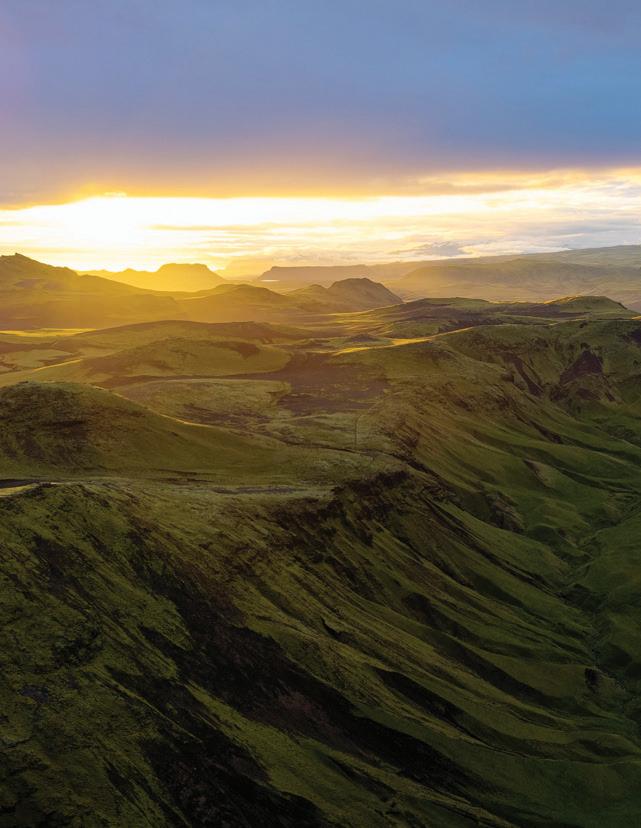
Tranquil, private accommodation; three different fly-fishing opportunities, hiking, riding (horses and overland) and well-being all in your own completely stunning, private valley.
I am a morning person; it is when I do my contemplating and there is no better place than Heidarvatn. I wake up early, others remain asleep (their loss/my gain) and I make myself a cup of tea and sit in front of the window and watch the view. It is transfixing, we are, after all, in Iceland where if you do not like the weather, wait a minute. Steam lifts off the lake, long white clouds form along the tops of the mountains and then slowly melt away as the sun lights up the peaks and creeps its way downwards illuminating the magical view in front of the house. It is completely beguiling, and one is totally at peace.
Other than those you have chosen to spend some magical days with, nobody is going to break that peace. You do not share the house with anyone, there are no fishing hours, no guides waiting, nobody will come and disturb you unless you have requested they do so.
The centre of Heidarvatn is the Heidarvatn lake set in the Heidar valley behind the town of Vik about three hours along the southern coast road from Reykjavik, Iceland. The 4,500-acre valley offers some of the most private and pristine Icelandic countryside there is. If you want privacy and solitude, you have found the right place.
The owners are aware that owning such a place is a privilege and a responsibility. Over the past 22 years of ownership, they have embarked on a rewilding programme to restore the valley to its natural state removing all
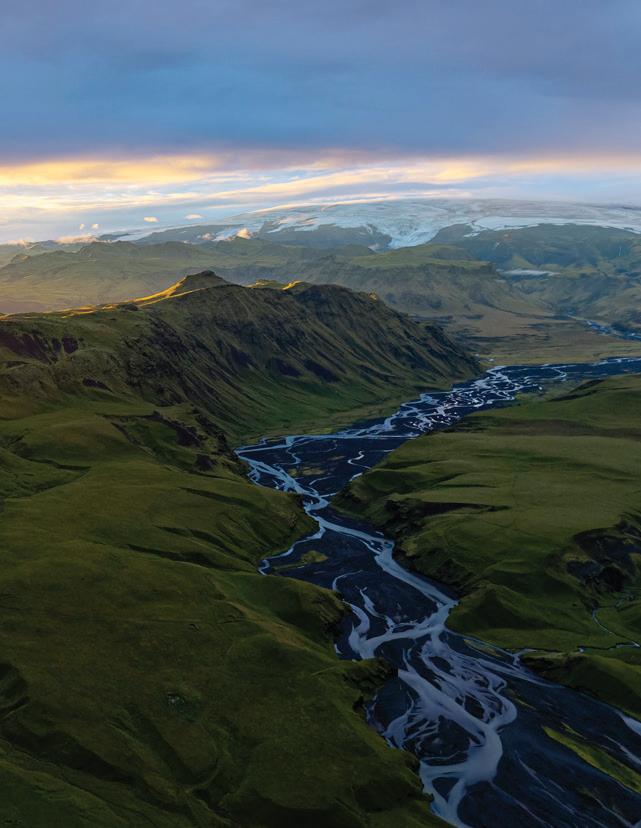
FIND OUT MORE

old farm buildings and infrastructure. They have also planted 300,000 native birch and willow trees which are helping to restore the landscape, reduce erosion and increase biodiversity ultimately creating increased matter to feed the water courses.
Though catering can be organised, both accommodation options are selfcatering using fully equipped kitchens. Despite its remoteness, the town of Vik is just ten minutes away and there you will find a full super-market and some good restaurants for your stay.
We suggest:
SudurVik
Black Crust Pizzeria for superb pizzas Drangar Restaurant in the Hotel Kria
It is truly an honour to have stayed and experienced such extraordinary place. Watch our


For the non-fisher
Heidarvatn’s location happens to be near some of Iceland’s most famous landmarks. The black sand beaches are just 19 minutes’ drive away, the Solheimasandur plane wreck just 22 minutes away along the black sand beaches.
The stunning Kvernufoss waterfall is just 32 minutes away. The backdrop to Heidarvatn is the stunning Myrdalsjokull glacier which feeds the glacial river Kerlingadalsá which can be fished. The famous Jökulsárlón glacier lagoon, where massive icebergs break off from the Breiðamerkurjökull glacier and drift to the Atlantic ocean is a fascinating day trip away, a 2 hrs 30 mins drive along Iceland Route 1 across volcanic plateaus and glacial rivers.

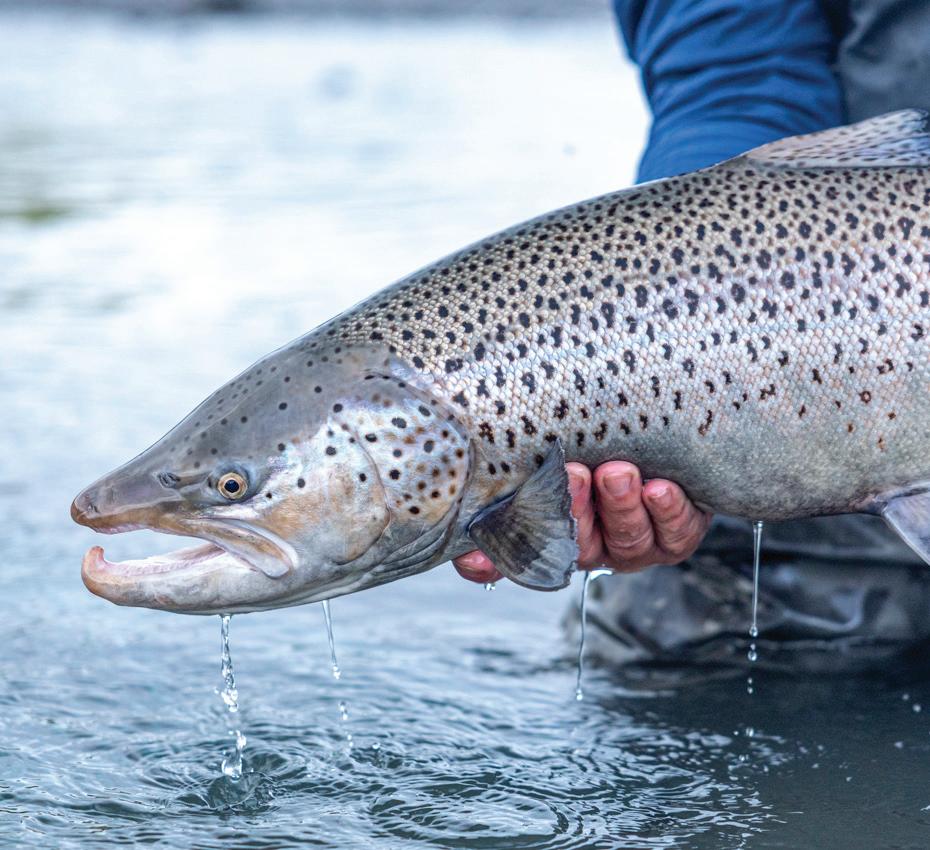
But to be honest, why go anywhere? Upon request, wildlife/naturalist guides, hiking guides, horse-riding guides (with horses) and cross-country driving guides can be arranged to be enjoyed within the Heidarvatn hideaway, there is really no need to go anywhere. After all, Heidarvatn has numerous waterfalls! Furthermore, why not combine all this with yoga and well-being right at the lodge. With planning and preparation, this is all possible and remember… you have this to yourselves!
Finally, where better to see the northern lights and experience winter in Iceland than Heidarvatn.
There are three options for the fishing and, if staying at the Riverside Lodge, they are all at your pleasure.
Lake Heidarvatn has resident wild brown trout, numerous wild arctic char and, at certain times of year, numerous sea trout and some salmon. I have sat in the lodge looking out over the lake and seen sea trout jumping in the distance. It can be fished from one of the two boats or


from the bank, wading out close to the drop off or along shingle banks. Some of the better spots include around where the Vatsna flows out of the lake, the bay and point near which the boats are kept and around ‘Pride Rock’ a huge rock that sits half in and half out of the lake, it cannot be mistaken.
The river Vatsna, runs out of the lake, it too has brown trout and char (mostly in pools near the lake) and the sea trout and salmon that are in the lake run up this small singlehanded rod river. This river is perhaps 15 metres at its maximum, two or three at its minimum. The pools can be extraordinarily deep and can hold a lot of fish, do not wade into them without care – some are two or three metres deep. Stealth is critical. Try and fish the pools from behind the fish with nymphs or dry fly or from a long way back with salmon flies or
streamers, some even avoid making a cast at all and lower the fly into the taking zone hoping it will be attacked by a sea trout. Hooking fish can be chaotic as they race around the pool jumping and the best approach is to simply give them the slack to do so and stay with them if you can if/when they leave the pool. Landing fish in lower water can be hard because the rocks are exposed between the pools and offer multiple opportunities to break the leader. Generally, for a while, pools are spooked if a goodsized fish has been caught and they should be left for 30 minutes at least.
Into the Kerlingadalsá the Vatsna tumbles, clear water meeting milky, glacial water. The clear water enters the Kerlingadalsá about 8 kms (5 miles) from the sea and of course the sea trout and salmon run through the Kerlingadalsá to get to the Vatsna and the lake.
It is probably not dangerous because it is shallow but the river is fast and milky so, if you have to wade, care should be taken when wading and we recommend the use of a wading stick. Mouth-watering water is often just a short wade away if the fast water can be crossed but we urge caution and care. Look for softer, slower water. The sea trout are happy to lie in shallow water because of the colour but they like to relax and enjoy soft but oxygenated water where possible. There are usually two options – cast over the fast water and mend to hold the fly in the slow long enough for the fish to see it before the fast water whips it away and induces the take or, if on the slow water side of the pool, swing the fly right into and over the fish. A skated fly can be effective as it will hang well over the fish and come right into the shallow water where they may be sitting. One may see them in faster water, but this is usually running fish off the tide, but they will seek slower water to rest in and that is where they can be caught best. They do not go as crazy as they do in the clear water because they cannot
see but they are wonderfully powerful and will tow you upriver cruising with ease only to turn and head down. They are bulldozers, broad shouldered and fat, very impressive and beautiful fish.
The char average 1 to 2lbs but there are larger fish.
The trout run up to about 2lbs but on occasion there are larger fish.
The salmon (the least numerous of the four species) will be grilse and multisea-winter fish but 15 lbs would be a big one.
The sea trout are numerous up to the 2lbs mark, there are plenty in the 3 to 5 lbs range and they go all the way up to and over 16lbs, the weight we have personally witnessed. The big fish in the right season are far from scarce; they are a very real possibility.
The best thing about the fishing is that one option may be out, two even, but rarely are all three options unproductive at the same time. Of course, there are


seasons but the strength to the fishing in this beautiful place is the variety.
I first visited Heidarvatn in mid-July of this year. At that time of year, the char are in season and so are the brown trout and certainly the bigger sea trout and even some salmon are beginning to be on the move. Had I known what I know now, I would have gone to the Kerlingadalsá looking for both salmon and sea trout as well. The weather was well into this year’s drought, so the Vatsna was low, but I still hooked a 10lbs sea trout which admittedly broke me quickly! The brown trout were on too. I was only there for a day on the water, so it was hard to pack it all in.
I returned with friends/clients at the beginning of September. We were following a good guiding friend whom I have worked with on Ponoi and in the Seychelles. He had been there
with guests the previous few days and together we shared notes and experiences which are as follows:
His first two days were low water, they caught some brown trout, a salmon and two sea trout from the Vatsna river and had a wonderful time. Then it rained and the lake and river rose. Fish began to appear, and they were able to sightcast upstream to fresh sea trout with nymphs and downstream with small salmon flies. They landed 11 sea trout up to 7lbs from the Vatsna plus some brown trout.
By the time we arrived, we now realise the water had dropped away again (the water table was very low after a long dry summer) and we were perplexed by our inability to sight sea trout in the pools and catch them as my friend had done. We tried upstream nymph, streamer and hitches but only caught
or lost salmon and small sea trout. We caught brown trout, a sea trout and char in the lake drifting in the boat but even the lake was not on fire compared to the stories we had heard.
We decided to look harder, and our attentions turned to the glacial river, the Kerlingadalsá which we approached both from where the Vatsna enters the Kerlingadalsá as well as driving down through Vik and up the river that way. The first time we went we saw nothing. The second time, we spent more time and this time the river began to reveal its secrets. We found soft, deepish water and there we found some serious sea trout landing fish from about 9lbs to 16lbs. We had other takes that did not hook up or broke us.
Let me remind you that the Kerlingadalsá is a milky, glacial river which will carry more glacial run-off with both rain and hot weather so it’s ideal conditions for best results are what we had, cool, dry weather. We started using black conehead streamers, evolved to smaller woolly buggers in black, green and white and concluded with the best fish of our three days, the 16lbs fish on a slowly skated muddler on the last evening.
I think these descriptions demonstrate how anglers need to move with the moods and conditions of the fishery. We are starting to learn that the lake and small river perform with water while the glacial Kerlingadalsá performs without as long as it is not too hot. The sea trout in the Kerlingadalsá are caught in the Vatsna and indeed in the lake under the right conditions with nymph, streamer and even skated or dry fly.
I believe we have only scratched the surface of understanding the secrets of Heidarvatn but one thing is for sure, there are some very special experiences to be had while enjoying the privacy of this magical place.
This is a not a place for someone wishing to use a double-handed rod and wants to cast their way down long pools swinging a fly. This is a single-hander’s paradise, interesting, technical, sighted (at times) fishing with the opportunity for special rewards whilst always enjoying the magic and privacy of this special place.
A word about flies – you could load every fly you own into your bag and take it with you – honestly, at times, anything could work. But if I did not have enough
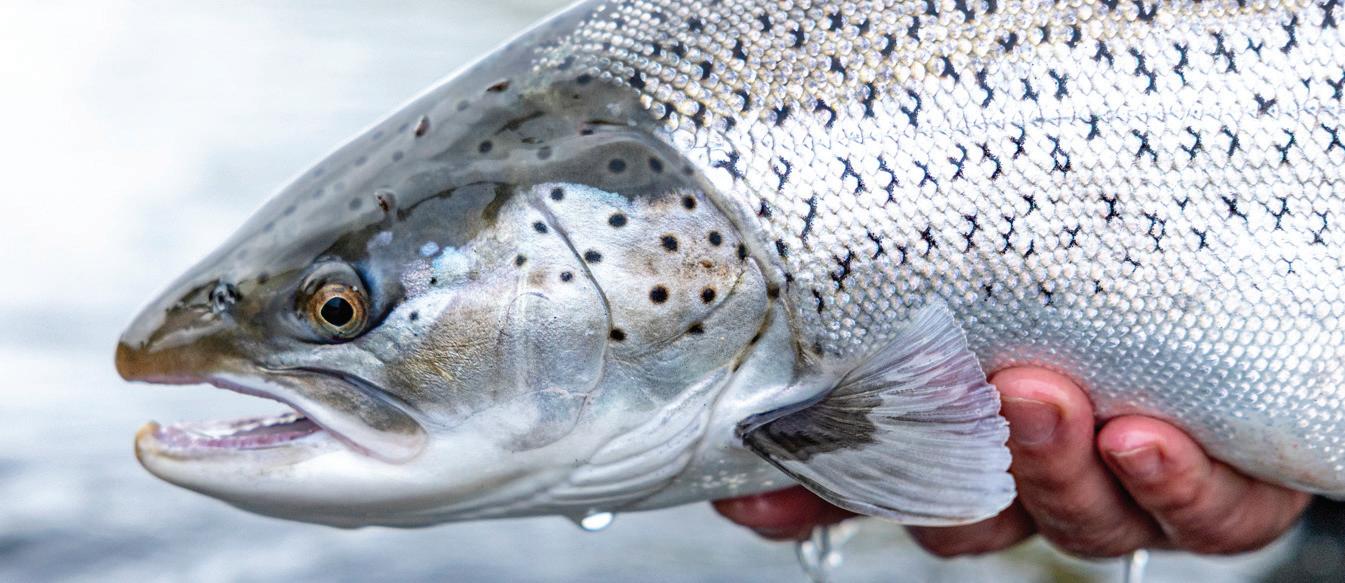
room I would focus on the following:
A set of small salmon flies for the river – blacks and blues with some sliver. These will catch the sea trout and the salmon.
A set of streamers based around the woolly bugger design but in various sizes and colours from pinks and whites to greens and blacks – lots of flash in them and varying weighed eyes. Sizes from small (1/2 inch/1 cm) up to a couple of inches. If they come with rubber legs too… great. Other streamers that worked well were full tinsel baitfish patterns in various sizes.
Nymph patterns of all weights and sizes but mostly small as in the photo above and mostly tungsten but a broad selection of weights and sizes. Some pink tungsten nymphs for the char. Include nymphs with rubber legs etc. Bring indicators if you prefer to use them.
Some sunrays and hitch tubes of varying sizes and some muddlers to skate, especially in black.
Lastly, I am convinced that bonefish patterns imitating shrimp, baitfish and squid but ideally tied on trout hooks for best hooking results.
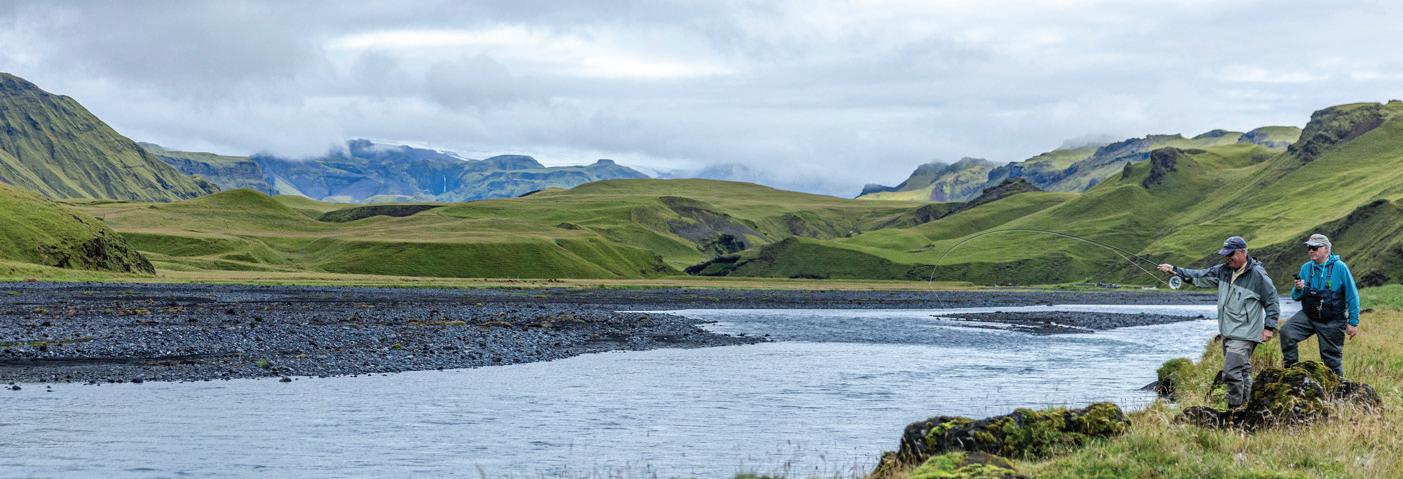


The Riverside Lodge comes with the best of the fishing. The owners suggest five rods between the two rivers and the lake, but we suggest two or maybe three. Partly because of pressure or less thereof and partly because there are currently only two good sized rooms. Two rods is a luxury like Heidarvatn itself, three would be fine, more a crowd.
The lodge has two large ensuite rooms (both rooms have nice ensuite bathrooms) and currently three tiny bunk-bed rooms which share a nice big bathroom between them. We have suggested to the owner to knock these together to make a third large ensuite bedroom. We are hoping they agree. There is a lovely seating area, a kitchen/dining room and a wading room and spare room for perhaps a chef across the way. Between the sitting room and kitchen/dining room is open space with seats along it almost like a viewing gallery to allow guests to just sit there and enjoy what they are looking at. The kitchen is well equipped, and everything is in perfect working order.
Just below and to the left of the Riverside House is the sauna with a massive window to give guests the best possible view as they enjoy their sauna. One cannot help but completely de-compress and relax here. There is nothing to disturb you except birds and their chicks.



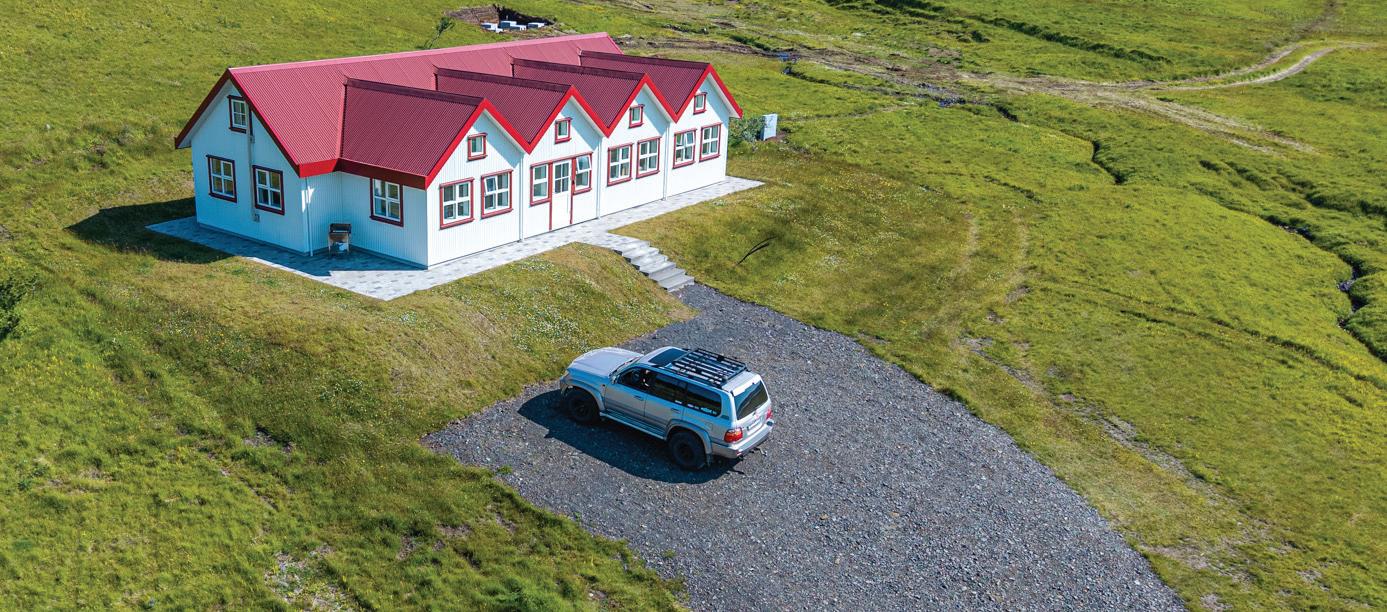

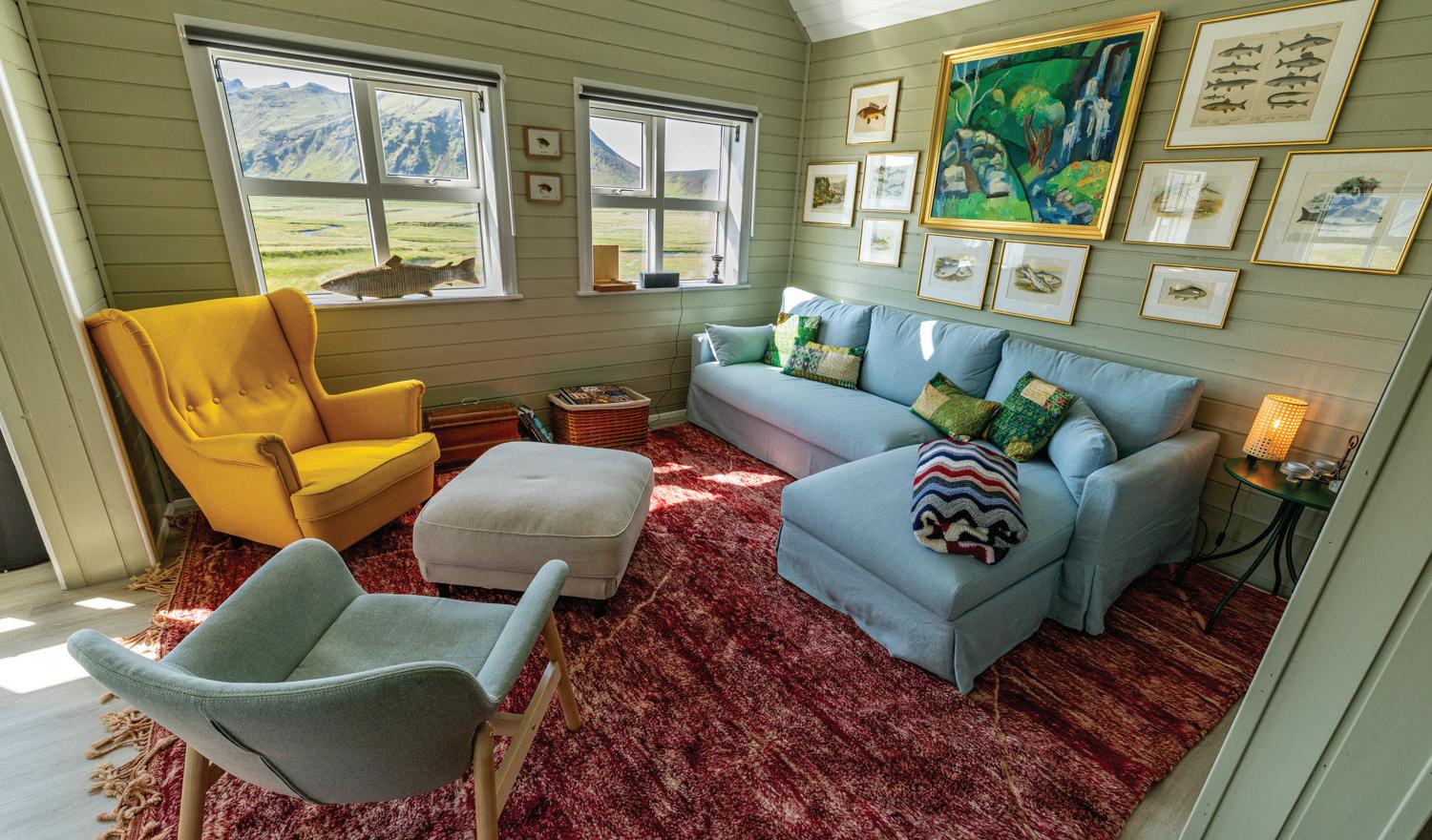
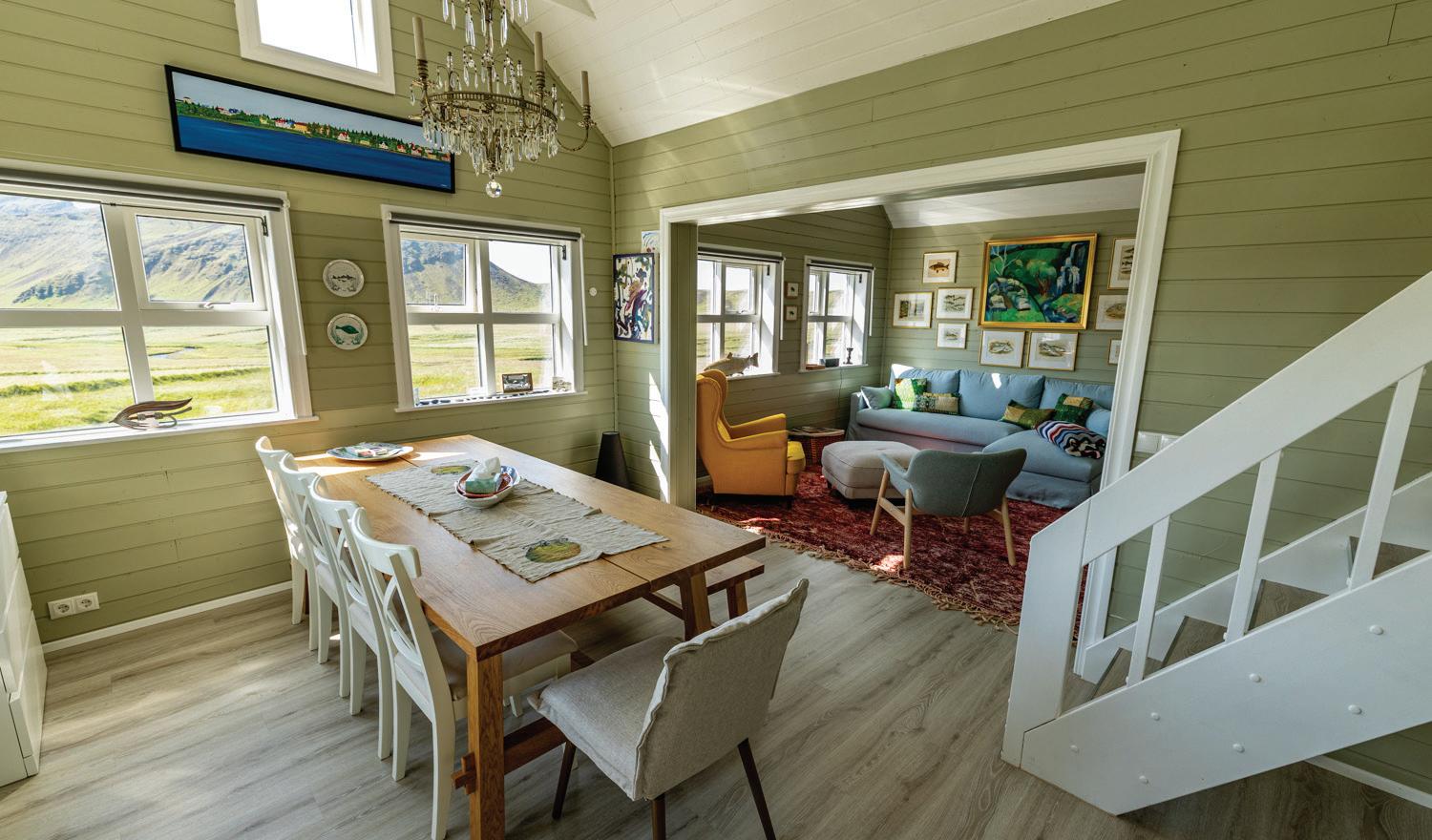
The Lakeside Lodge is for larger parties and only comes with fishing on the lake. It has a capacity for up to 8 people across four double rooms with four bathrooms.
It too has a sauna positioned for best possible views out over the lake. There is a seating area which leads into the dining area which in turns goes into a fine kitchen. This is the more traditional of the two buildings in Icelandic farmhouse style. The two lodges cannot see each other though one does see this lodge as one makes the drive to the Riverside Lodge. There is a mud room in the entrance hall where coats and waders etc would be stored. Riverside Lodge
15th April to 14th May - €4,100 per night
15th May to 20th June - €3,600 per night
21st June to 19th July - €3,800 per night
20th July to 10th September - €5,200 per night
11th September to 10th October - €4,300 per night
Cleaning Fee €350
Guide fee €800 per day - one day mandetory
Lakeside Lodge
15th April to 14th May - €1,300 per night
15th May to 20th June - €1,900 per night
21st June to 20th July - €1,600 per night
21st July to 10th October - €1,900 per night
I have worked in this industry for well over 30 years and have been lucky to witness many stunning, extraordinary places. It may be that I am finally getting old and therefore have a greater appreciation for wild places, peace and solitude and, as I mentioned, sitting with an early morning cup of tea contemplating life while enjoying the stunning view, Heidarvatn is truly special in every way. I am a fisherman so I find the fishing challenging, interesting and exciting but were I a hiker, horse rider or simply someone seeking tranquillity it would still be right up there for me. I am no yogi, but I can even imagine doing yoga looking at that view!
Equally, and sadly, of all the myriad of places I have been to and have been lucky enough to fish, none have got better, most have got worse, and, in most cases, the reason is too much pressure on a wild fish resource for the sake of just a bit more money. To date, the Heidarvatn team, are doing it right, keeping fishing pressure light and to a minimum. I hope that their wisdom continues to prevail, and this extraordinary place can defy the odds.
I keep wondering if I have made it clear enough how much I love this place, simply the place, with the fishing a great big fascinating and challenging bonus. Anyhow, I hope so! Heidarvatn is truly a world class hideaway.
Contact Tarquin M illington-Drake


BY UNDER THE INFLUENCER - CLIENT WRITER
7 NIGHT 6 DAYS FISHING, WITH SINGLE ROOM $5825 PER PERSON.
FIND OUT MORE

With this being my fourth visit in the last 20 months, I arrived in Corrientes eagerly looking forward to spending time on the Parana River again. Growing up on the banks of Severn, there was something about Parana that reminds me very much of my days fishing the tidal structures of the Severn, a huge dirty brown river, somehow still full of life.
I overnighted at the El Alondra Hotel, which was perfectly adequate. The food was good, staff friendly and accommodation comfortable. I was collected on time for my transfer to Don Joaquin. I was due to fish here in September last year, but unfortunately, due to personal reasons, I was not able to travel. The lodge were kind enough to roll my week over to another week of my choice. Due to heavy storms, the journey from Corrientes to Don Joaquin took just over 3 hours. The roads are perfectly fine, so no issues with that. I had the offer of stopping on the way to the lodge, or lunch on arrival to the lodge, I had requested lunch at the lodge, but we stopped on the way anyway. Just before the town of Esquina, we turned off the main road onto a farm trail leading up to the lodge.
We were now on the 770 hectare privately owned family estancia. 2km down the track and you are greeted by the owner and all the lodge staff who were dressed in traditional gaucho style clothing. I was immediately given a tour, and I was impressed that the lodge was only built 12 years ago. There was a sense of authenticity which I rarely see in my travels. The family have run the estancia for the last 29 years, and, as well as the fishing, they offer a full gaucho riding experience. The interior decoration
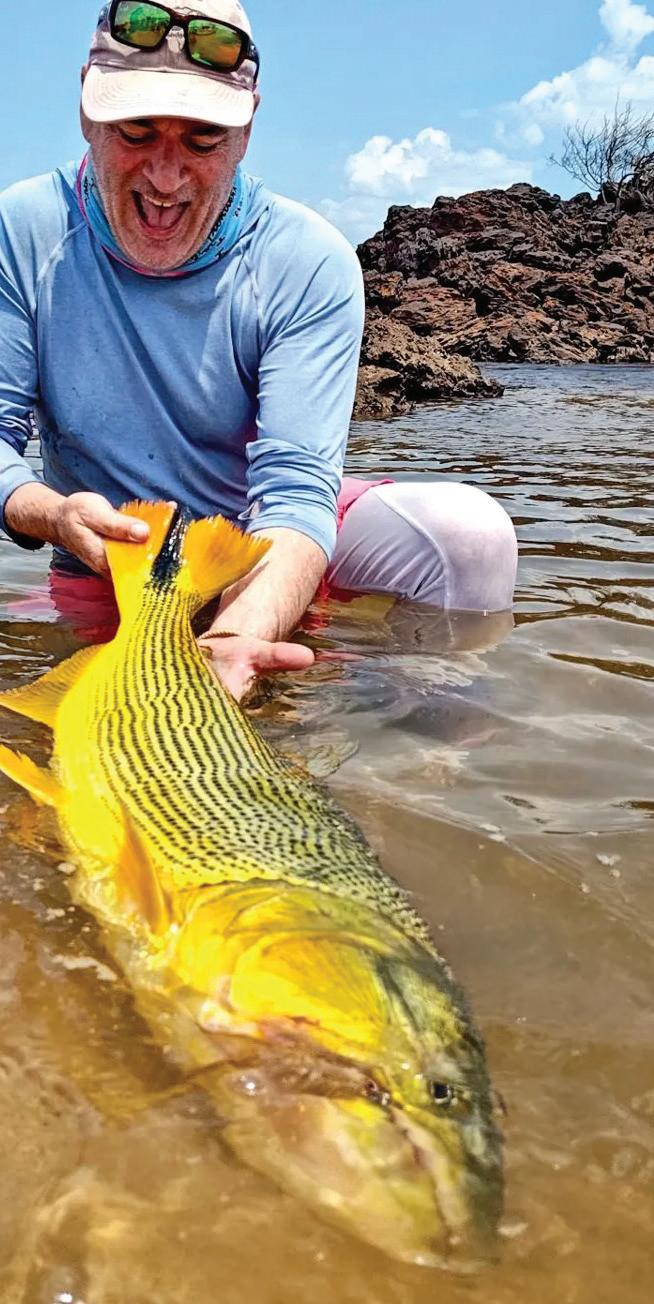
was suburb, with several dining areas including a grill area where you can see your food being cooked if you wish. I was shown to my bedroom which was an utter delight, the bed was enormous, the room fully air conditioned, the bathroom luxurious and a much-needed touch of luxury. When greeted by the Englishspeaking owner, I was immediately made to feel at home, and we sat down for lunch together.
I spent the rest of the afternoon at leisure looking out over the river. I could see dorado chasing bait as I waited for the other anglers to return. Later on that evening the co-owner returned after a day’s guiding and we talked about the fishing at great length; we looked through my selection of flies and suggested we go for a quick cast to maybe get a dorado or a wolf fish as the sun was setting over Don Joaquin. To my astonishment, as we walked to the river, we were joined by two of the waiting staff, one to carry my rod, and one to carry my drink! I took one look at them and said, “I am a fisherman not a tourist, I will carry my rod!”. An early night was had in anticipation on what lay ahead.

There is something about dorado that really intrigues me, and I have an ongoing battle with them. I was up at 6 the following morning for breakfast for a 7am departure time. Due to low water conditions, I was unable to enter the river the normal way via the lodge’s jetty, so a 20-minute drive through the town of Esquina was necessary to get to the marina. A classical Parana River marina boat launch, where my captain and boat was waiting for me. Today I was being guided by Ramon, the owner of the lodge, and the captain, Nico, who both grew up on the river. After a quick but necessary boat orientation, we set off under blue skies, Again, due to low water, the journey to the fishing spots was extended to 40 minutes, but this wasn’t an issue as the boat journey was beautiful going through narrow marsh parts of the river system to reduce as much time as possible. The boats are fast and well equipped, but take some time to get used to, they are not your traditional skiff that many may be used too. Having fished the river on three occasions before, I knew the size of the fish in this part of the river were going to be smaller than in the areas that I had previously fished, the guides are very open about this, however there are 20lbs fish to be caught if you are lucky. This is purely down to the structure of the river.
Ramon wanted to show me some of the better places on the river, where the chances of catching bigger fish are higher so we started fishing to sunken logs. This is very much a traditional way to fish for the bigger dorado. A floating line and dorado fly with a 6ft leader and a 12-inch metal trace attached to the fly, pretty solid, regular gear. There is a definite
skill in getting the correct angle to pull your fly in front of the log or structure, but if there are dorado there, a savage take is the result.
We continued this a little while in the search for the big fish. We caught a few in the 13-14lbs range and while using a 7-weight rod the fights are short but epic with the fish often jumping three or more times. The opportunities through the day continued, but then we moved on to do some flats fishing, which involved getting out of the boat and walking around the flats that had been exposed by the lower water. Fish were seen in most places and opportunities were in abundance. Before we knew it the day was gone, we had lunch, and due to the increasing heat we headed back to the lodge at 4pm. I arrived back to see my favourite Argentina meal being prepared outside my room, lamb and beef on the cross, all locally sourced meat.
On the following day I just wanted to do flats fishing, so we just drove straight to the flats in the boat. What I have learned quickly is that low water is a positive not a negative. I loved this fishing before, with the flats fishing I love it even more! To my astonishment, as we approached the first sand bar there was chaos ensuing, dorado feeding everywhere. I put my fly straight into the middle, and as soon as my line hit the water, it went tight, a 12lbs dorado, quickly released. I had another shot into the group, hooked up but it came off. We then continued to walk up the sand bar, there were multiple opportunities, but I missed them all. The fishing was on fire for about 2 hours with dorado feeding on sabalo baitfish in the shallows all over the place. It had been a long time
since I had seen that number of fish in a river, anywhere in the world. This was sight fishing on a new level for me. I struggled at first to see the fish, but the guides eyes will always be better than mine and we got there in the end, covering over 10,000 steps as I later found out!
The fishing did die off as the heat increased over the day. I have fished this river enough to know that heat can be a major issue, not to say the fishing is bad, but it is not as good as it is in the morning without the heat of the day. The days can be long, in the heat, but the action of the fishing makes it worthwhile, and with the level of comfort at the lodge it is easy to recover and relax on your return. I should point out that you can come back to the lodge for lunch and a nap and skip the heat of the day or you have lunch on the river and nap in the shade. If you come back to the lodge, it likely means you cannot travel as far to fish because you are going back for lunch. On my third day we only managed to fish for a few hours, before an electrical storm with huge winds, wiped out the third day. These are rare and simply just bad luck.
Feeding and tailing in the waves atop pancake flats, the permit fishery was a contrast of its own. On the outer barrier islands of the south coast, the interior turtle grass flats were pristine—curiously absent of bonefish but teeming with permit. These fish surfed the waves, foraged in whitewater, and disappeared just as quickly, reappearing 40 feet away. It was maddening, addictive, and some of the most exciting permit fishing I’ve ever experienced.
Hooking a permit, however, is just the beginning. These ocean-going fish drag you through knife-sharp debris and out into the deep blue sea. Landing one feels like hitting

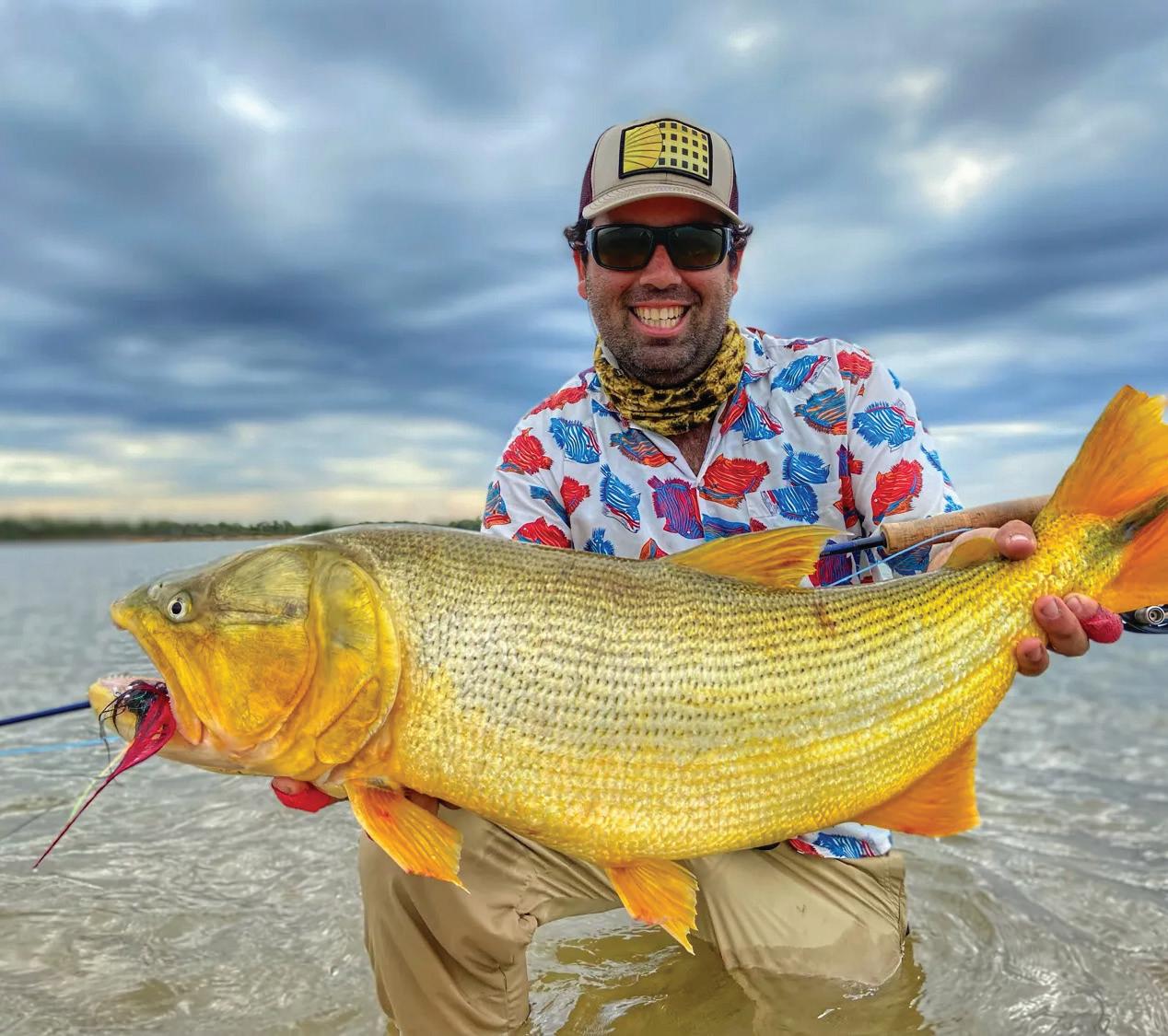
the lottery—and I’m ready to buy another scratch-off ticket soon. What I learned: Don’t let Koz get ahead— he can cast and has eagle eyes. Wear proper high-top flats sneakers for ankle support; my new Simms neoprene booties didn’t survive the first day. And while it’s tough to pull yourself away from feeding tarpon, trust me—do it.
On our final morning, with driver’s licenses in hand and a slight Puerto Rican rum fog lingering, we headed back to San Juan for our flight home. During the drive, Capt. Bryce reflected on the uniqueness of Puerto Rico. Despite feeling like we were in an exotic land thousands of miles from home, we were only a short hop from Miami. Which, as it turns out, was fortunate—because for the first time in 25 years, I’d forgotten my passport.
The fourth day continued as previous days, I had worried that the size of the fish would not have been able to hold my
attention for the full-time fishing, but it did, there’s something about these dorado that make them incredibly appealing and I put them right up there on my favourite fish to catch list. The thrill of seeing a 20lbs dorado smashing bait, in waters that are no more 18 inches deep, moving more water than a small cayman 40 meters away, and having the ability to drop your fly, no more than 6 inches away from its nose, is a challenge I have yet to complete. I had that opportunity but guess what… it didn’t work…again!
What I have learned is by simply downsizing the rod a little for slightly smaller fish, you have the same fun and it is less hard work in the hot weather. This is very similar to GT fishing in the Seychelles; however they are a very different proposition, you can tease and tempt a GT, but unless you land your fly right on top of a dorado’s nose, you are not getting a response. They are lazy but violent takers. It is almost as if there

is enough bait in the river and unless its right in front of their face they will not bother, especially a single fish on the flats. However, if they are in a pack, which I have experienced on many occasions, success is almost guaranteed.
On every flat I fished, there were fish present, whether that was in a pack or singular fish. I was astonished at the quality of the fishing, my mornings were spent flats fishing until I was mentally exhausted of looking at sabalo and trying to find dorado swimming amongst them. If you find them, you were pretty much guaranteed action especially at every drop off a sand bar. After a lunch on the river, and a snooze, we would fish to logs or structure with poppers and streamers. The fly was being eaten as soon as it hit the water, but these are small fish up to 8lbs, a necessity for learning how to set a hook properly as they are a difficult fish to hook.
My evenings were spent at the lodge being hosted by an amazing team that were fast becoming friends. The whole staff team had links to the estancia, and all lived on the grounds as do their families. For me, this
was the key to my enjoyment at Don Joaquin, they just seem to get it right with their level of dedication and attention to detail, they were always there on hand and despite their limited English they were hugely keen to look after you. After an exhausting days fishing on the river this is most welcome.
I was asked if I wanted to see the working estancia and had the privilege of watching the gauchos herding the cows to be dipped, this was an epic experience which I can fully recommend if you are interested in the farming life and horses and appreciate horsemanship. Some of the gauchos were also the waiting staff that helped around the lodge in the evening which added to the homely family feel of the place. Will I return? Of course. The hospitality and the fishing being the main two reasons, but thirdly the price of the fishing at Don Joaquin ($4,750 for single room/shared boat) which is more than reasonable. For the rate I paid I had a boat to myself and was looked after in the most beautiful accommodations. Flats fishing for dorado is right up there with any fishing on flats that I have done, and for me, the most challenging, for an absolute fraction for what you pay elsewhere.



This is my second blog about Providence, the last one was April 2017. What an extraordinary amount has taken place in the past seven years for all of us, but it has been like time has stood still at Providence or has it? Last time, I travelled on the MV Dugong, it was an altogether different experience on a bigger boat with more guests and staff, three to a cabin, three to a boat etc and therefore cheaper but the fishing, though different, was no less.
Providence is actually part of the Farquhar group of islands, but it is NOT Farquhar. Farquhar is 56 km south of Providence and is the southernmost atoll fished regularly in the Seychelles. Providence is the biggest atoll at 345 sq
kms, 55 km north to south and 14 km east to west. There are two islands, Cerf and Providence North, with a massive lagoon system between them. From Cerf Island to the tip of Madagascar is about 320 kms. From Mahe to Cerf is 700 kms southwest!
Three things of significance have happened to Providence Atoll since 2017.
The 1300 metre airstrip was completed on 20th March 2019, almost exactly a year before the Covid disaster hit us all. Blue Safari, perhaps better known as Alphonse Island Co, began to operate its fishing operation for just six rods at Providence in rotation with the MV Dugong commencing in January 2023 using the catamaran Quo Vadis as its mothership.

BY TARQUIN MILLINGTON-DRAKE


Perhaps the most significant event was in January of 2024 when the guides on Blue Safari’s Quo Vadis catamaran spotted a number of fishermen poaching in the lagoon and reported the incident to the Seychelles authorities. With the assistance of Blue Safari, the result was that 137 people were arrested, taken back to Mahe and then deported, and 8 boats were scuttled at Providence. They were unlicensed fishermen from Madagascar poaching the flats and a real example was made of them. If ever there was a demonstration of the good the presence of a fishing operation can do, this is it. Without the presence of the fishing operation, these very remote lagoons, easily accessed from Madagascar, would be entirely raped of so many species from sea cucumber to grouper, GTs etc.
In the case of Quo Vadis, just three boats fishing the 345 sq miles is the difference between the destruction of a stunning, wild atoll with extraordinary numbers of marine species and desolation.
The trip was booked back in 2023 and let that be a warning to you – if you want to go to Providence on Quo Vadis you now need to plan an extraordinary amount of time ahead and even then, you are likely to go on a waiting list before you get your space. I was lucky to be the beneficiary of a very good friend of the team falling very ill at a bad time. This time I tried Qatar Airlines via Doha. I think that the calibre of the airlines (Emirates v Qatar) is different but comparable, but I actually preferred the Qatar schedule and process. On the outbound, we left at a civilised time like
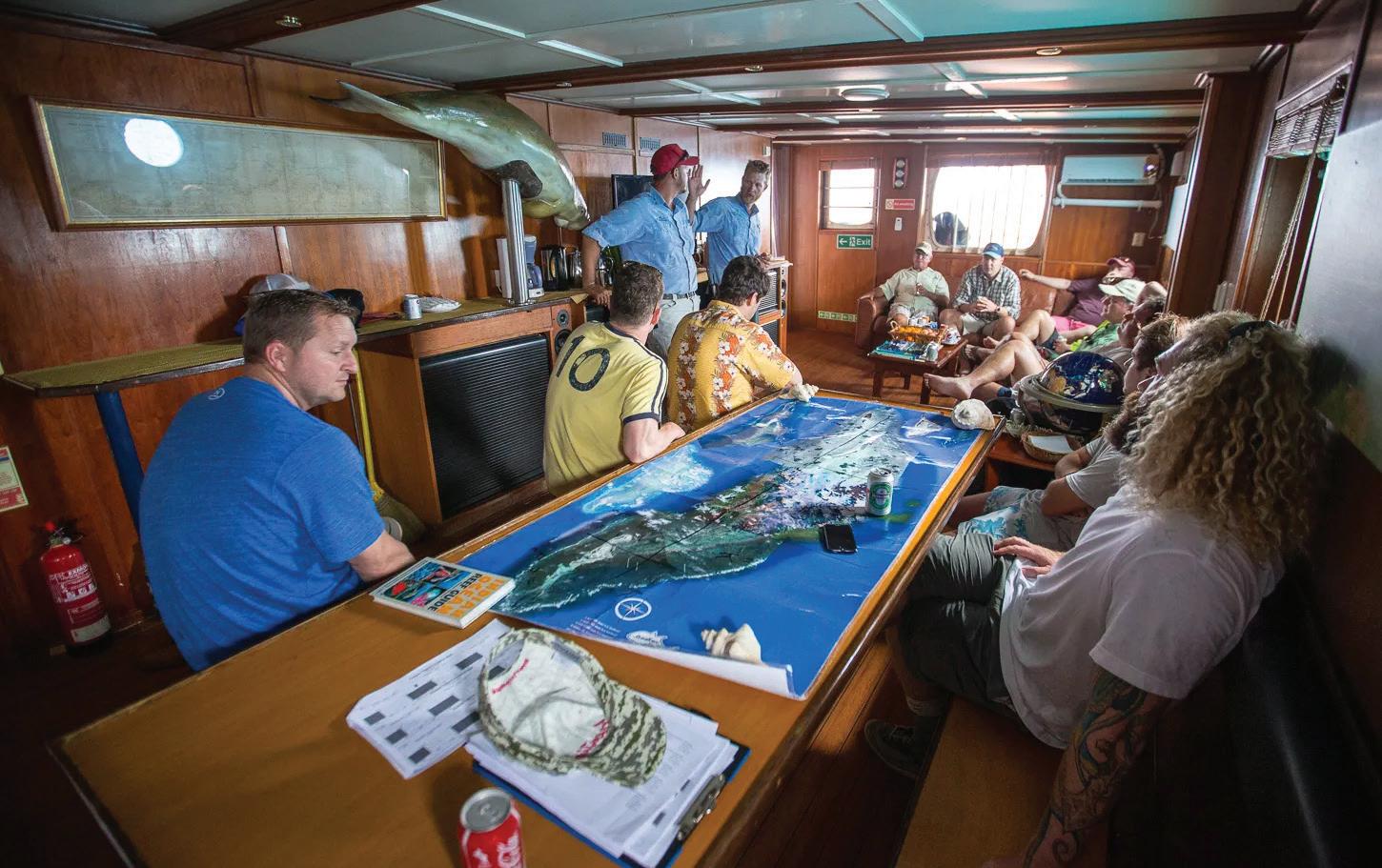

Starting October 2026, Blue Safari will be offering 20 weeks per season at Providence Atoll. The season will run from October to December and January to April annually, with specific start dates varying each year.
These trips will be based on the 150ft Mayas Dugong - NO LONGER QUO VADIS - The Mayas Dugong is not known for luxury, but rather for its functionality, stability, and range for operating at Providence Atoll. Pre the 2026 October season start she will undergo a light refurbishment that will include some new furniture additions. What makes this trip more appealing is that it is an all-inclusive offering with drinks, alcohol, daily laundry, Wi-Fi, loan fly rods and reels included. Standard trips will accommodate 10 guests on shared skiffs (2 per skiff), with the option for 2 single skiffs and cabins per week. There is the option to extend the group size to 12 guests on request as Mayas Dugongcan accommodate up to 12 guests in 7 en-suite cabins. She will be accompanied by 6 purpose-built skiffs with poling platforms, each guided by experienced guides.
The 2026 Rack rates can be found below:
Providence Atoll, shared room, skiff and domestic flights: $ 16.950
Providence Atoll, single room, skiff and domestic flights: $ 18.950
Single Skiff Upgrade: $4,500
Conservation donations and tourism levy: $266


Learn more a bout Providence
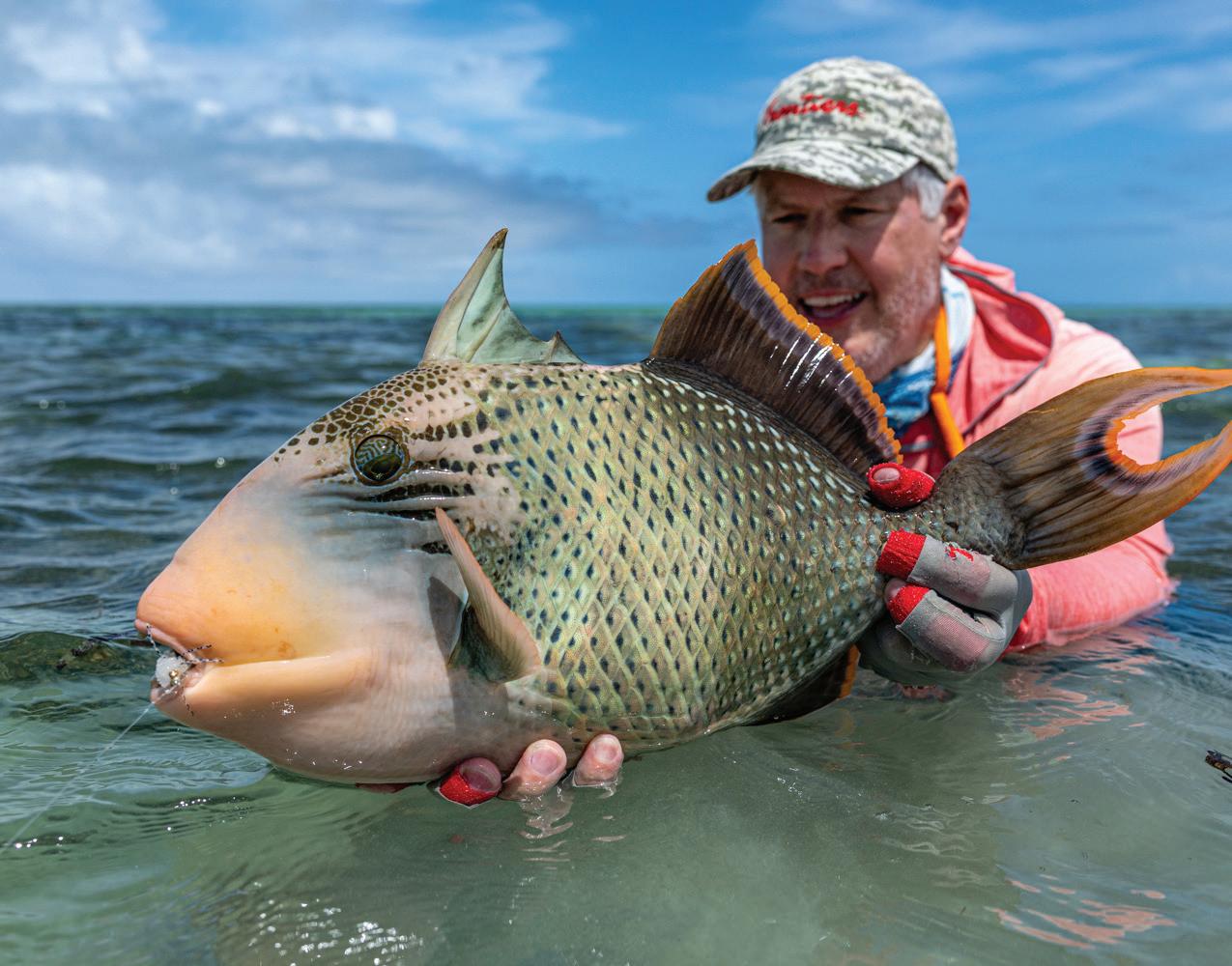
about 3pm. On arrival in Doha, we did not have to go through another security line before being allowed into the departure area for the next flight. That was hassle gladly avoided.
We arrived, a bit later than Emirates which meant arriving at the L’Escale Resort and Marina Hotel a little later which improves your chances of them having a room ready for you on arrival. In theory checkin is much later. That in turn means a good nap before lunch, a fine massage in the spa and then the traditional dinner at Bravo on Eden Island – it never looks like much, but the food has always been fabulous! After a good night of sleep, off to the Domestic check-in (not IDC Hanger like the old days) just a few minutes away and off we go via Alphonse Island direct to Providence. No more flying to Farquhar
and boarding the boat there and then sailing the 56 km to Providence.
The Providence airstrip is in very fine condition, and we were soon walking to the beach followed by a short walk across a flat to the launch to go out to Quo Vadis. It is worth noting that the walks to the launch can vary from very short to a decent distance depending on the tides and consequently, it is worth having your flats boots (or crocs etc) handy for the walk out. The guides and crew will carry bags etc for you. Once at the launch, the journey to Quo Vadis was three minutes.
It was the arrival at Quo Vadis where the difference between the operations became apparent. Quo Vadis has a crew of four, a Captain, Chef and two crew plus our three guides. The whole crew
therefore was greater than our party of six! As that party of six (we were actually just five due to another cancellation) one has the boat to yourselves and that is a real pleasure. There are three cabins so not sharing is not really an option unless you are prepared to buy two tickets and have your own room and boat/guide. The boat is very clean and spacious. The cabins were perhaps smaller than the photos suggest, and the beds are pretty close to each other, but they worked and were comfortable and cool. If you think you are going to be on the side the sun goes down, pull all your blinds down before going fishing to avoid the room heating with the evening sun.
If I had a criticism of Quo Vadis, it would be to try and find a way of allowing the breeze to make it through to the back deck which is where we spent a lot of time because we were eating, socialising and occasionally fishing off the back of the boat. We did not make nearly enough use of the foredeck where all the breeze was. On arrival, we were given the usual briefing and then had lunch and set up tackle.
On four of the seven nights we were there, the boat was surrounded by fish including plentiful GTs, shark etc. So much so that, although we caught a few each evening it seemed silly to thrash it because there were so many. However, there were times in the evening when baitfish and/or krill would appear to the blue lights of the boat in numbers and then we had to match the hatch or catch nothing.
We caught GTs on small crabs, small deceivers and even smaller little baitfish imitations which I really enjoyed. I am

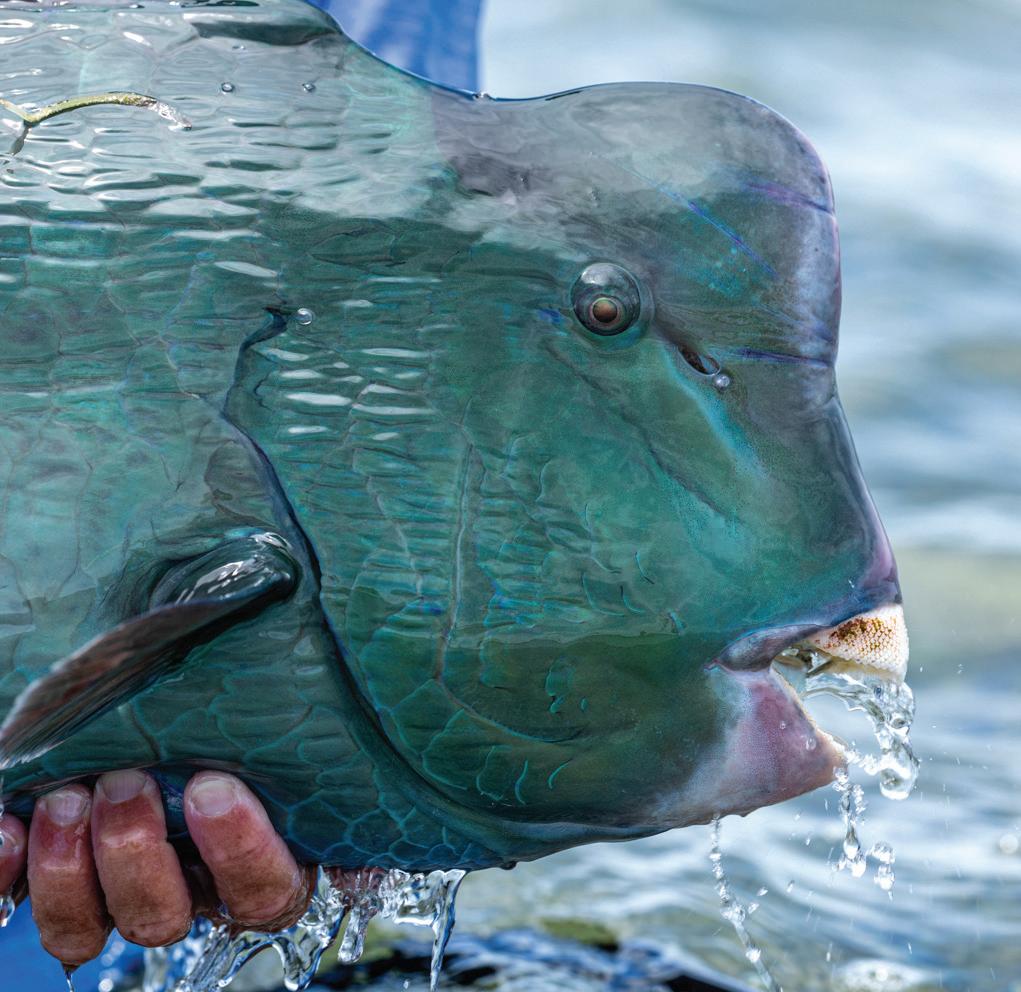


not certain how approving the guides were of our fishing out the back, but we were measured, and they were not asked to get involved in the releases etc. All the dinners were good, we had steak, chicken, fish, pork etc and it was all excellent given where we were. Breakfasts were made to order with some very good porridge and freshly cooked bacon and eggs prepared just behind where we were sitting.
Our first morning brought the second significant difference to the MV Dugong set-up. We jumped into skiffs not pangas and there were just two of us per guide and no plans of any significance to wade unless of course we wanted to. The guides firmly believed that we would see and therefore get far more ‘shots’ at whatever species using the boat and covering more ground. In contrast, we would have been wading from the pangasor rotating between three of us fishing from them.
In summary therefore, how does one choose between MV Dugong and Quo Vadis? Price is probably the number one consideration which is understandable. Opportunity is also a consideration at the moment – Quo Vadis has no space for 2026, maybe, just maybe in 2027. I dare say one could get on a trip with MV Dugong in 2026. The one offers basically a more luxurious experience with better food for a private party and a better guide/angler ratio while the other offers a humbler operation, maybe sharing three to a room, definitely three to a boat unless you pay a supplement BUT also, ironically, possibly cheaper access to a single room. Either way, the fishing and the guiding will be world class.
What did I learn on this trip? My main takeaways were how I handled a triggerfish when it was following. When fishing other atolls, one gets opportunities for triggers
but not enough to learn from one’s mistakes. Fewer opportunities mean one is perhaps more ginger and careful about trying to not waste the opportunities. I was lucky on this trip and had so many encounters with triggers I was able to be coached and iron out my hesitance.
What I was doing is making decent casts, getting the triggers to follow and even allowing them to go down on the fly when I should. My failure was not stripping hard after the fish had gone down on the fly and my explanation was fear of spooking it if it did not have the fly. What I had forgotten was the armoury of teeth at the front end of a trigger which meant if the fish did not have the fly fully in its mouth, my stripping hard was only pulling against pearly white teeth, not tissue, therefore I was not pricking or spooking the fish. Once I was less cautious and gave the fly a good, long, hard strip my hooking and landing ratio went up dramatically and if I did not hook
up, the fish would keep following and I would get another chance of a take.
I am not going to describe a blow by blow of each day but needless to say, as has been the case whenever I have had clients fishing Providence, the fishing was spectacular and everyone caught what they hoped to catch whether it be GT’s, milkfish, triggers, bumpies or barracuda! We caught them all and more including some really nice bones.
There was one special day fishing with John. We had a wonderful morning hooking two bumpies and landing one of them, a GT, and two or three triggers. After lunch things seemed to go quiet and John was quite happy to let me do the standing on the bow until things livened up! Finally, we stumbled on a GT but concentration had slipped and we did not see it early enough. Then we stumbled on a couple of triggerssame problem! I asked John if he felt things had
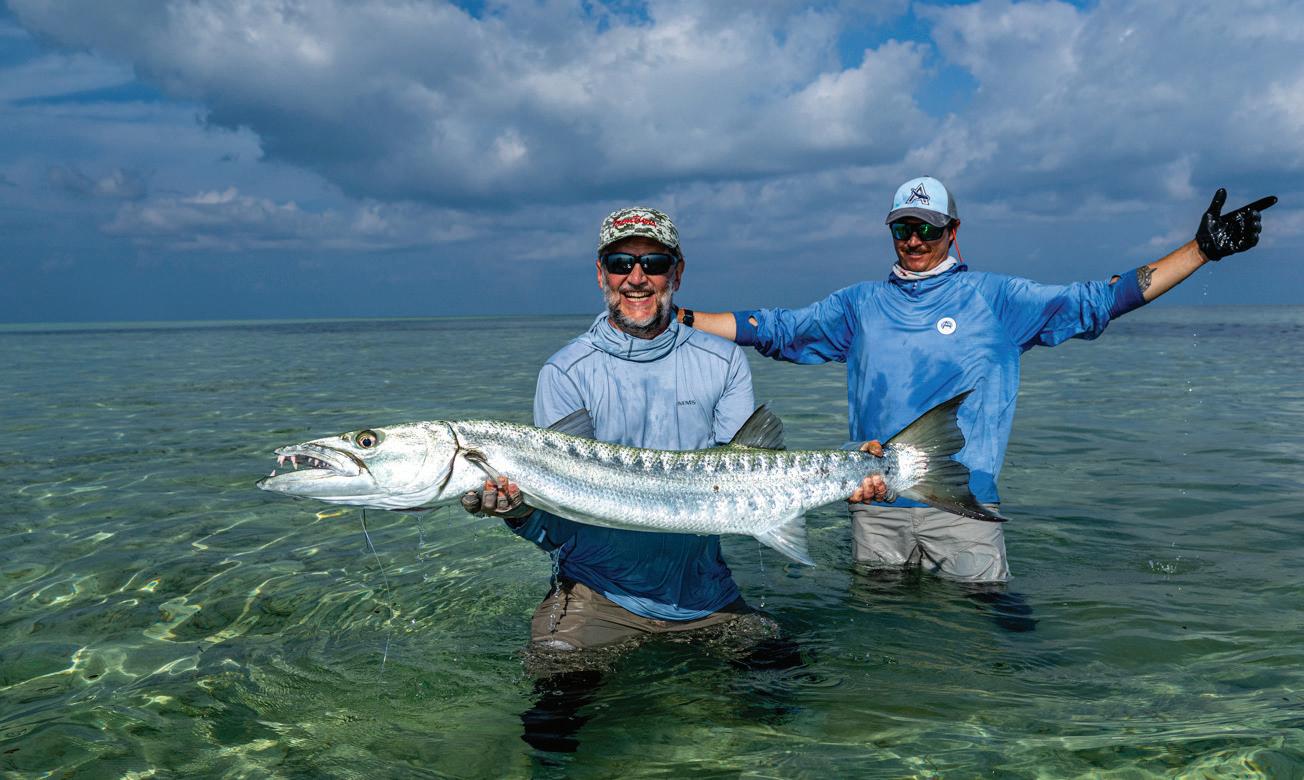
livened up enough to bother his standing on the bow. He reluctantly gathered his 6ft 5in frame and up he got on the bow. As is so typical of John, the man who really does not care for GTs and much prefers triggers (I think he caught 7 triggers on the first day), it was only about a minute until Stu asked him to make a cast to his left… the rest is on the video below! This is a man at the peak of his fishing powers – he has done it all – he has nothing to prove – no targets – every day he is out there fishing is winning the Champions League, something he hopes his beloved Arsenal will achieve this season. It is extraordinary how successful fishermen who really dont care and dont have egos and targets are –if only we all had such a relaxed approach we would all be so much more successful!
My role was general dogsbody – keep John safe, wind the reel when he got cramp, keep an eye on the fish in terms of the coral heads, film etc but it was an absolute pleasure witnessing John landing this lifetime fish while giggling to myself that
normally he has no interest in catching GTs at all!
We saw permit but did not land any. I think the starkest difference between Providence and the other atolls (I have fished them all) is how willing the fish are to take. Of course, there is the odd refusal but insignificant compared to other atolls, even the likes of Cosmoledo and Farquhar. The cause of failure to catch at Providence is rarely the fish refusing but angler cock-up! The reason has to be the size of Providence in relation to the number of rods.
There were various stories as to why it occurred but, on our week, MV Dugong and Quo Vadis were there at the same time which is not supposed to be the case, but we did not see them and to be honest, unless arranged, we never saw our fellow rods during the day either. For me, as stated so many times by my friend who was sadly missing from the trip, Providence is THE place. With thanks to Graham, Stu, Cameron and the Quo Vadis Team.
Tarquin Millington-Drake Director of UK Frontiers Travel Ltd



There are multiple lodges in this area in which you could exten d your trip.
Alphonse Island
Great for families or non fishing partners
Beautiful 5* accomodation
A huge range of species on offer
Cosmoledo Atoll
Luxury, eco-accomodation
Great number of GT's and many caught on the flats
Fantastic mix of species
Contact Tarquin M illington-Drake
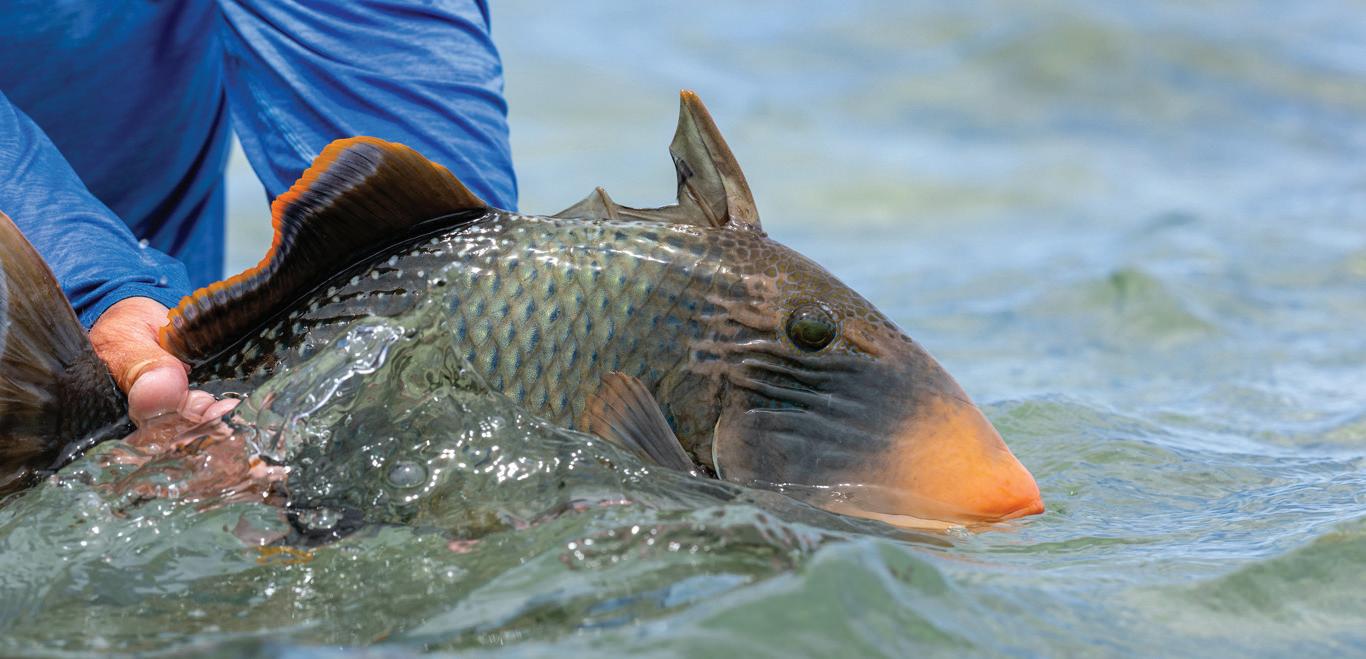
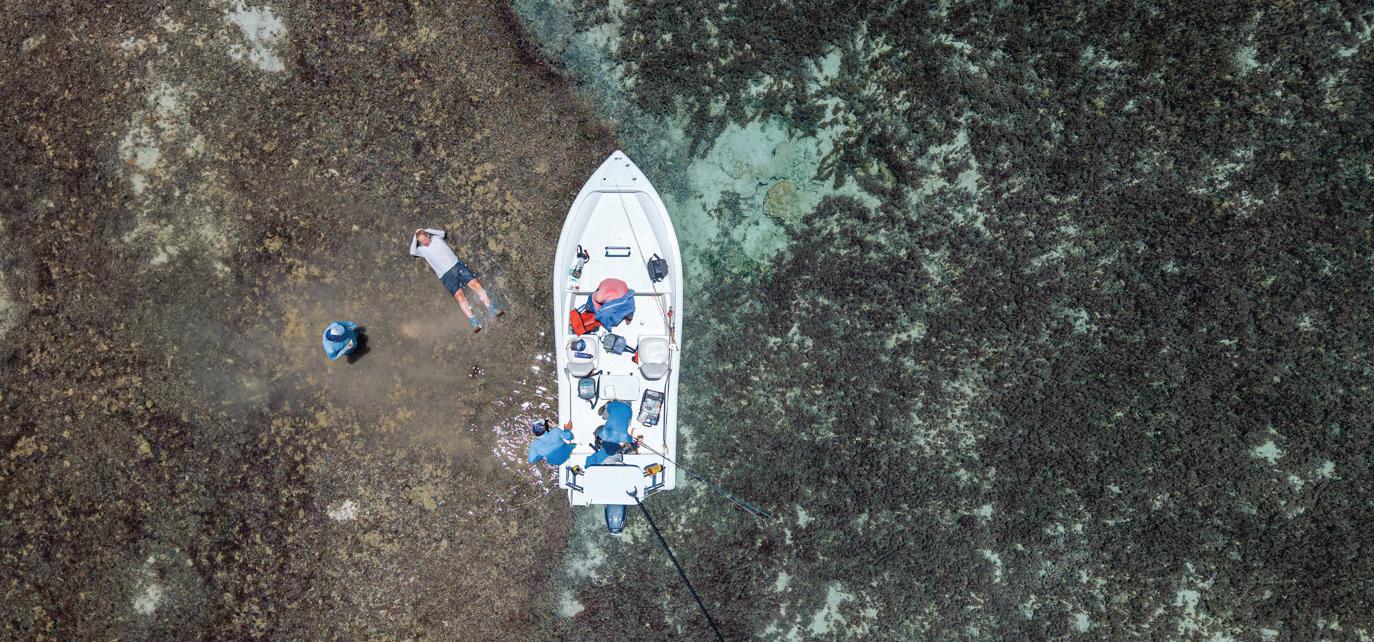


Is this the easiest saltwater trip out there?
BY TARQUIN MILLINGTON-DRAKE

It is snowing outside, and I have only been back from 27/28 degrees and sunshine for 48 hours. My story actually begins back in August of 2023 when I went to Xingu which was a bit of a disaster – you can read the blog here. There was a shining light on that adventure, and he was called Everton Pires, and he was the Head Guide and, as it turned out, jack of all trades in looking after my party because the camp had been understaffed. He was one of those guys who works hard, cares about the clients, really tries to do a good job and yet was very torn between flying the flag for the lodge he worked for and telling the truth. During our chats, he nonchalantly mentioned that when he was not in the jungle, he ran a little tarpon operation from his home city Recife and I should pop and see him some time. It was a kind invite not a business invite. We stayed in touch.
A few weeks ago, we got chatting again over WhatsApp and from his boat he asked me to speak to Guido Perillo, his partner. I did not know he had a partner, but Guido was available, and we chatted and he explained his role. Guido is no slouch either, he has guided in Xingu (as a colleague of Everton’s), Tierra del Fuego/Rio Gallegos, trout in Argentina, Bolivia for dorado, Rio Marie, Brazil for peacock bass, on the Nordura and Midfjardara in Iceland, Russia, King salmon in Chile and his hometown is right by La Zona where the biggest dorado are caught. He has just been invited to guide for Six Rivers in Iceland next summer, that is a real compliment in itself.
So, this is how Silver King Brazil works between them. You have chatty, energetic Argentine Guido in charge of sales and logistics, and you have the laid back but crazily hardworking Everton in charge of the fishing and guiding. They have allocated their time wisely with Guido’s international lodge experience and know-how ensuring all goes well away from the fishing (back-up guide too) and Everton in charge of the fishing which he has got to know and
understand on his own using a kayak for the past eight years. Both are in their 30’s.
The fishery is unique in many ways. The season runs from mid-September to mid to late March. First, nobody else fishes for tarpon here. There are no other lodges or guides. You see the odd local with a net fishing for mullet and occasionally a guy with a spinner which does not seem very effective! If staying near Recife, they fish four different rivers (not clear water), each with their own character. The biggest and most productive (but perhaps smaller fish on average) is the Capibaribe river which is in the centre of Recife itself.
This may be appealing to some and not others, but it is an eclectic mix of towering office and residential blocks, not the cleanest water and yet thousands of ducks, families of capybara and a thriving tarpon population. From the water one can witness the beautiful old town, modern hotels and all around the
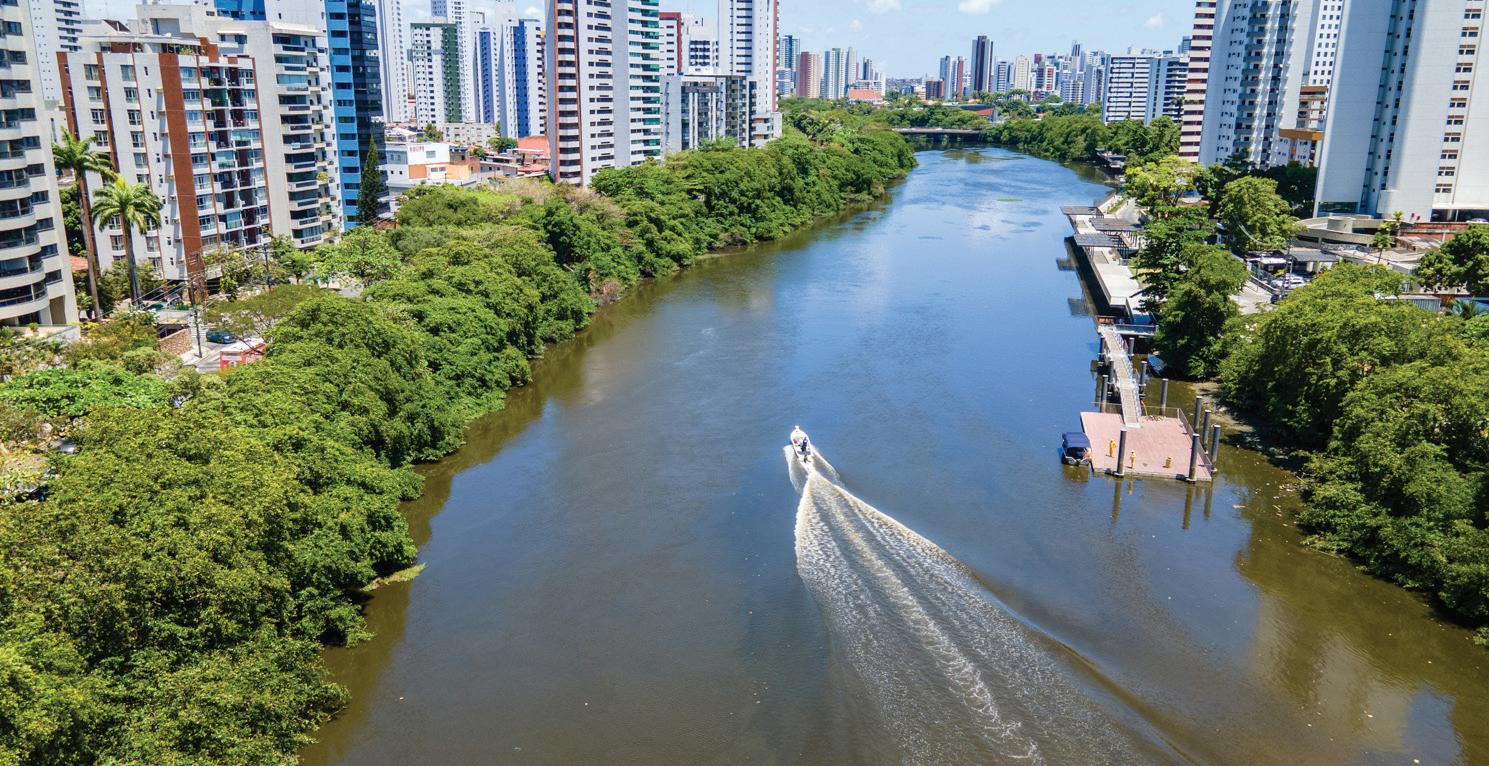


culture of Recife going about its business with the ever-present mussel fishermen toing and froing from their fishing areas, boats empty and then laiden.
Another river is the Sirinhaém which is deep in sugarcane country as far as the eye can see but they have clearly not been allowed to clear along the rivers so when on the river, one is deep in the trees and in your own world. The last two rivers accessed from Recife are the Ipojuca and Jaboatão which are also more out in the countryside where one only sees local people living in remote tiny settlements.
The Capibaribe river is the most productive with a smaller average size but that does not mean that fish of 30lbs or more are

not possible (I had a crazy 30lbs + fish) while the other three rivers have less fish but with a bigger average size. The hookup statistics they suggest are reasonable at 10 a day for the Capibaribe and 5 per day for the other rivers but I have to say I had more hook-ups and saw fish rolling everywhere we went and all day long. To my eye, there is absolutely no shortage of fish at all, the challenge is getting them to take and keep hold of them once they do! There is another fishing programme out of town by over 100 kms which can be a separate trip or combined with days in Recife focusing on big tarpon but success is not guaranteed.
With a population of 1.5 million, Recife city is the capital of Pernambuco State,
This may be the easiest saltwater trip out there
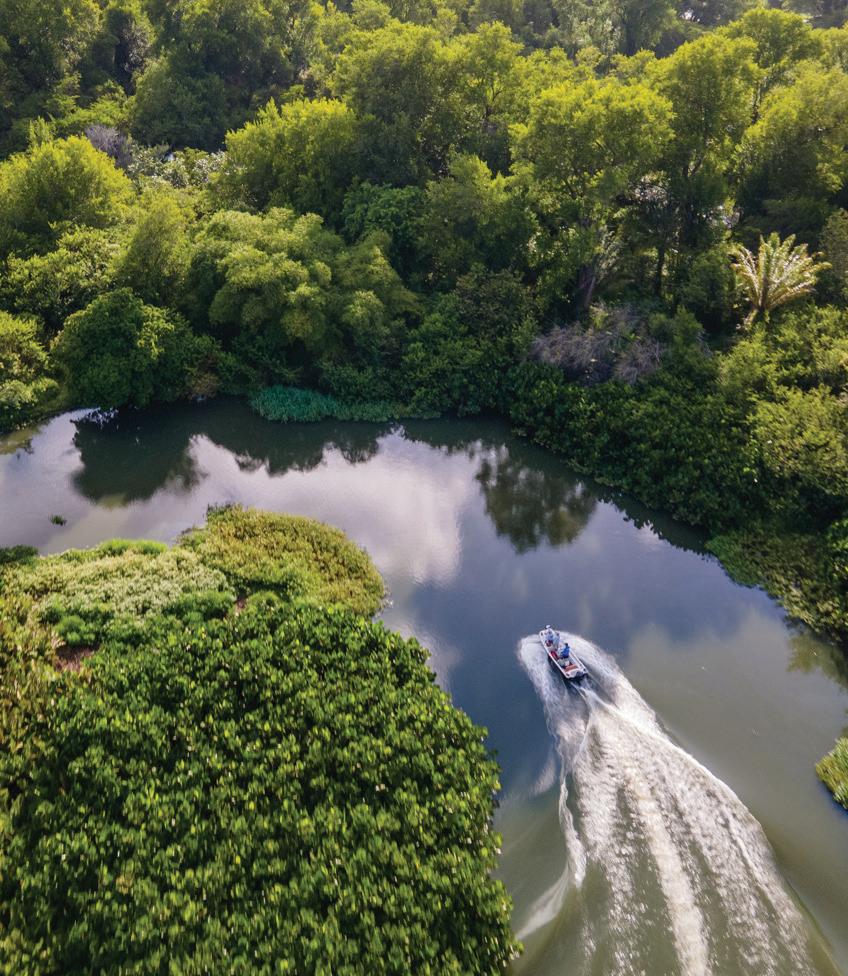
northeastern Brazil, and centre of an area that includes several industrial towns. It is an Atlantic seaport located at the confluence of the Capibaribe and Beberibe rivers. Recife has been called the Venice of Brazil because the city is crossed by waterways and its component parts are linked by numerous bridges.
In the second quarter of the 16th century, wealthy Portuguese colonists lived in splendour at Olinda, just to the north. Recife was then merely an anchorage that handled their exports of sugar and their imports. It was raided by French pirates in 1561 and by the English in 1595. In 1630 it was captured by the Dutch who held it for 24 years. The town prospered under the governorship of Count John Maurice of Nassau. In 1710, the inhabitants revolted against the magnates of Olinda in what is now called
the War of the Mascates (i.e., peddlers) because the small tradesmen of Recife tried to organise a municipality of their own. In 1827 Recife became the official capital of the province of Pernambuco. Recife has shared in the prosperity of northeastern Brazil that resulted from development promoted after 1960. Although its retail and wholesale trade have grown in response to the region’s increases in population and wealth, the market area and the walkways of the city’s bridges are crowded with vendors selling small items.
Besides the State Museum, there are museums of sugarcane and of popular art. There are many historic churches and public buildings, including the Governor’s Palace and the Santa Isabel Theatre. The beaches of Boa Viagem, on the city’s south side, attract large numbers of tourists.






Recife is home to three major stadiums, reflecting its obsession football!
Recife has a symphony orchestra, a conservatory of music, and several theatrical companies, including the nationally renowned Pernambuco Amateur Theatre and the Popular Theatre of the Northeast. Reflecting the area’s distinctive cultural composition are the folklore festivals: the Xangô is typically African, while carnival time is vibrant with the compulsive music of the forró, an emotionally and physically exacting dance.
There is a flight with TAP Air Portugal from London to Lisbon (2 hrs 10) and then Lisbon to Recife (8 hrs) direct. It leaves the UK in the morning and gets to Recife about 2130 in the evening. Guido meets guests and drives them about 45 minutes to where they will stay. It is possible to eat at the airport before leaving it but generally, it is time for bed.
Due to the nature and location of the rivers Everton and Guido have not set up a lodge. They rent houses for the season which are comfortable and functional for guests with ensuite rooms, Wi-Fi, hot water etc. They cater to all your needs at the house including bringing in Gilvan, the chef, a lovely guy who does a great job. You really want for nothing and as a four-rod max operation (at present) it is all very relaxed. I have suggested to the guys that they consider improving things further with a list of menu options before arrival, so they know that guests are getting to eat and drink exactly what they like. We enjoyed pork, fish, steaks on the barbecue, shrimp, chicken etc with the added bonus of proper ripe fruits and avocados etc.
They will get you up early for two reasons, the first is fishing related to tide timings, the second is to get you to the fishing avoiding
the traffic. What takes 20 minutes on empty roads in the early morning can be an hour and 20 minutes once everyone else is awake. Besides, a 4 am start is 7 am in the UK and it really is a breeze. Have a relaxed breakfast…
I could’ve easily spent at least another week in Italy just exploring the area. This region is teeming with rich art and culture, with numerous castles, museums, and miles of hiking and biking trails.
Fly fishing in the Dolomites is more than just a fishing trip; it’s an opportunity to immerse yourself in one of Europe’s most beautiful and dramatic mountain landscapes. Whether you're an experienced angler or a beginner, the pristine rivers and lakes of the Dolomites offer something for everyone. It’s a place where you can not only catch fish but enjoy the unspoiled beauty of this majestic landscape, an experience as varied as the flavors of Trentino cuisine.
You drive to your launch site (journeys from 20 minutes to 45 minutes) and off you go fishing. If in the city, you have lunch at a restaurant, if out of town, you have sandwiches and fruit. Generally, you get back to the house at about 3pm. Relax, swim in the pool (or the sea –their houses are usually near the beach) and then enjoy a caipirinha, a cocktail made with cachaça, sugar, lime juice, and ice, before dinner at perhaps 6 and bed around 8pm which is 11pm UK time. Basically, you can stay on the UK time, and I can tell you, there is zero jetlag! On your last day, you can wake up and fish as normal, come back and have dinner as normal, and then pack and shower and get to the airport for about 8.30pm ready for your flight to Lisbon leaving at 11.10pm. You land in the UK at 5.30pm, head home and go to bed! You literally waste no time and feel perfectly fine on your return! Somehow, you have had some great fishing, some lovely relaxed


down time, fun with Guido and Everton and you are not jet-lagged or exhausted at the end of it.
Perhaps I should have mentioned this above, but it will not be long until the guys can loan you rods and reels etc, and this leaves your packing requirements so small, I reckon it would be possible to ‘carry on’ and not have to check any luggage. You need a couple of fishing outfits and maybe a couple of changes of clothes for the evening (it is very casual) and you are sorted. On your feet you can wear whatever you like – they may get a little wet but crocs, flats boots, flip-flops or any variation will do. You do need sun gloves, gaiters for sun protection around the neck and sunscreen. Temperatures are around 27/28 C (80 – 82 F) degrees. I experienced VERY few bugs – the odd mosquito around the lodge but I did not have any need for bug spray when out fishing. I would
recommend hand sanitiser particularly for the fishing days in Recife. I wore standard flats trousers, not tights and shorts à la Seychelles, there seemed no need. You do not really wade much at all other than to maybe get a little bit wet getting into the boats here and there. Long-sleeved flats shirts or T-shirts and perhaps socks for sun protection.
The standard rod is a 9-weight with an intermediate sink-tip and perhaps a second rod with a floating line. Lines need to be salt or warm water versions. Leaders are generally 40 to 60 lbs straight and the flies tend to be smaller baitfish or shrimp imitations. ou perhaps wait a couple of seconds to let the fly sink a bit and then medium strip but vary your strip. As is so often the case, the key is how to handle the take.
Local fishermen…
DO NOT TROUT LIFT – in fact barely lift at all – strip strike!
Step One – pinch down on the line with the hand through which you are stripping the line to stop the fish taking any line at all.
Step Two – keep stripping with the other hand to keep the fish tight at all times. Avoid yielding an inch of line until you have to.
DO NOT – be focused on getting the fish on the reel, it inevitably leads to loosening your connection to the fish or waggling your rod as you wind which increases the chance of the fish coming unstuck.
DO, look where your line around your feet is and make sure it is ready to go out should the fish run.
If my experience is anything to go by, you will see rolling tarpon from 3lbs to 40 lbs
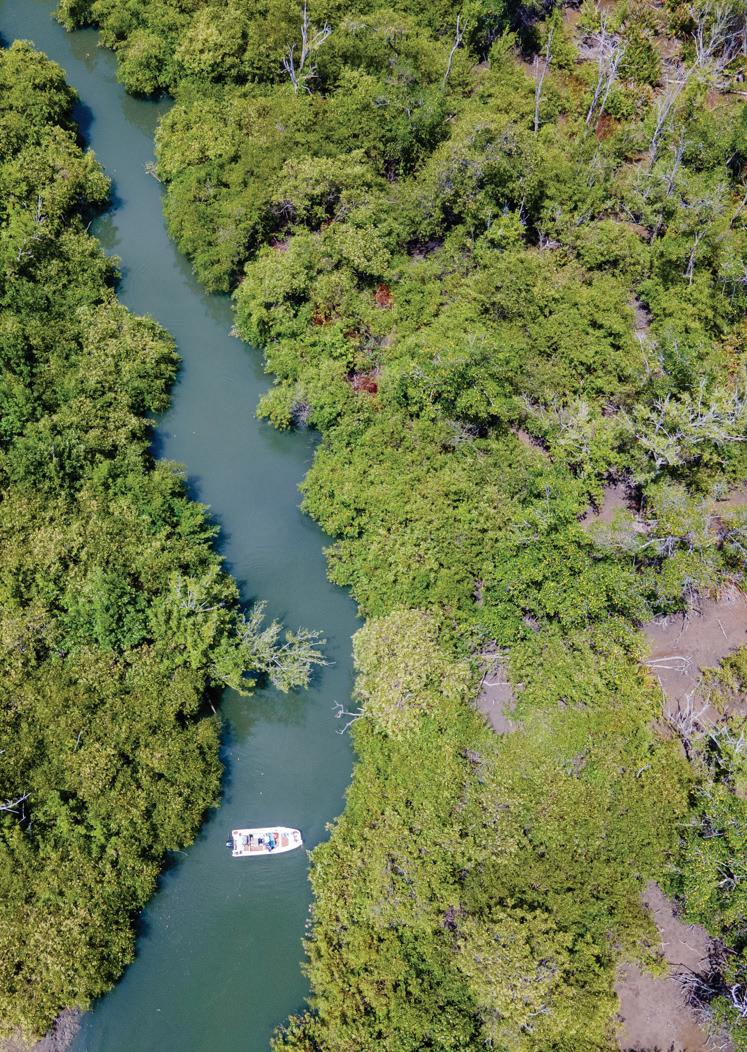




all day. The tides are key in terms of taking times, but a take is possible at any time, but the prime times are around when the tide begins to drop and to a lesser degree, come back in.
These are baby to adolescent tarpon but do not be put off by this. When a fish of anything over about 6lbs takes, chaos breaks out with the fish jumping, running etc. They will often jump into the mangroves and no matter what the size, there is not much you can do. They can fall off very easily, but they can also literally jump into trees and either get off that way or cause an almighty tangle! I think my key message is… do not be put off by the idea of a 15, 20, or 30 lbs tarpon. They are fabulous to catch and spectacular and I have renewed respect for these fish. My fish of 30lbs took off jumping and screaming across the river, I had other fish crashing through the trees, those first few seconds really are utter chaos!
In summary, this is an easy, fun, normally productive and interesting trip in perfect comfort and great convenience all at USD$4,100 based on shared room/shared guide, USD$4,600 based on single room/ shared guide or USD$7,200 based on single room/single guide. What is also exciting is we will hear more from Everton and Guido, so far, they have only scratched the surface in terms of exploring the myriad of rivers up and down the coast and nobody is more qualified than them to work them out. There will be opportunities to join explanatories in the future.
Shared room and guide - $4,500
Single room, shared boat - $5,000
Single room, single guide - $7,600

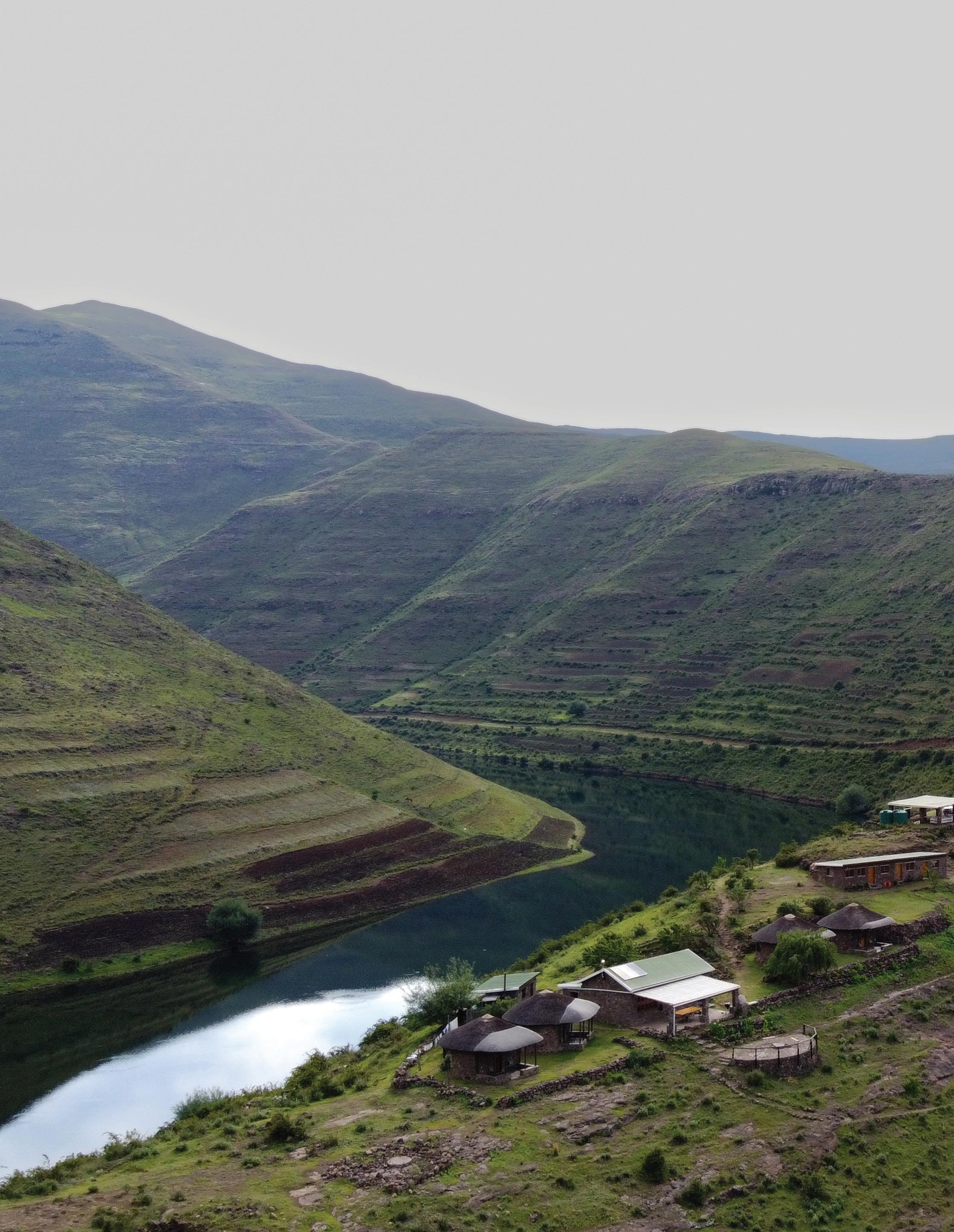
BY RODDY HALL

We have all become spoilt as travelling fishers over the last two or three decades. The world opened up to us and we have fished destinations that we never would have dreamt of when growing up. As someone who has worked in the fishing world since the late 1990s I have been fortunate enough to have fished in and travelled to many fascinating and remote places over the years.
However, a recent trip to Southern Africa was a reminder that there are still some fascinating places out there. Despite living in South Africa for more than a decade I had never visited Lesotho. This small country is completely surrounded by South Africa and contains the highest peak in Southern Africa. It is known as the Mountain Kingdom for a good reason, and I encountered some of the most awe-inspiring mountain passes I have ever driven. Recently Keith Clover, one of the owners and founders of African Waters, invited me to visit the remote lodge they have built on the Bokong River, near the Katse Dam, in the centre of Lesotho.
The drive from South Africa into Lesotho is easy. I spent the night in the charming small town of Clarens before heading to the border crossing the next morning. Everything is efficient and it takes a matter of minutes to exit South Africa and enter Lesotho. It is immediately apparent that you are in a different country. The landscape is beautiful and as the drive progressed and I left the built-up areas behind it became more and more spectacular. People use horses to get around and donkeys to carry loads up and down the steep terrain.
This is a country that often sees snow in the winter and the people have an iconic look with balaclavas and warm blankets to protect themselves from the harsh climate. From the border to the camp is a drive of around 4 hours. We can arrange transfers for groups which I would recommend unless you really want to do the drive yourself. The tarred roads were all excellent although vigilance is always required. You tend to miss the spectacular views if you are driving yourself and concentrating on the road. The last hour of the drive is off-road, on a gravel road that does become quite challenging, a high ground clearance vehicle is required.
Arrival at the lodge is quite spectacular. The last hundred metres or so of the drive involve quite a steep climb, then your car arrives on a flat grass area with the most amazing panoramic views over the river valley. The head guide and staff were waiting for me and quickly had taken my bags down the steep path to the lodge. The lodge is quite small and well laid out and the location is impossible to beat, with
a stunning view up and down the valley from its position built into the hillside. There are four spacious twin-bedded stone cottages, two either side of the large kitchen/dining/relaxing building. There are also two full bathrooms, each with a separate bath and shower, shared between the four rooms. Considering the remote location the camp is very comfortable, and everything has been thought of. There are indoor and outdoor seating areas with a fire-pit and wood burning stove to keep you warm when the temperature drops. Wifi is only available from one spot outside the guides rooms and there is no cell phone signal, so if you do visit be aware you may be out of communication for a lot of the time.
As suggested by the name, this is not just a fishing lodge run for commercial gain. The camp employs over 50 individuals from the local community on a rota with all staff training undertaken by African Waters. They also support a River Ranger programme whereby the local community provides protection to the natural resources by ensuring best practices and local legislation are adhered to. Sustainable cooking projects, water delivery programmes and logistical upgrades (footbridges and road building) are a few of the many projects the camp sponsors.
Guests are encouraged to bring contributions to the local community including stationary for the school and sanitary items and a percentage of the trip cost goes to the community. We walked through the local village several times on the way back from fishing and it is fascinating to see how people live in
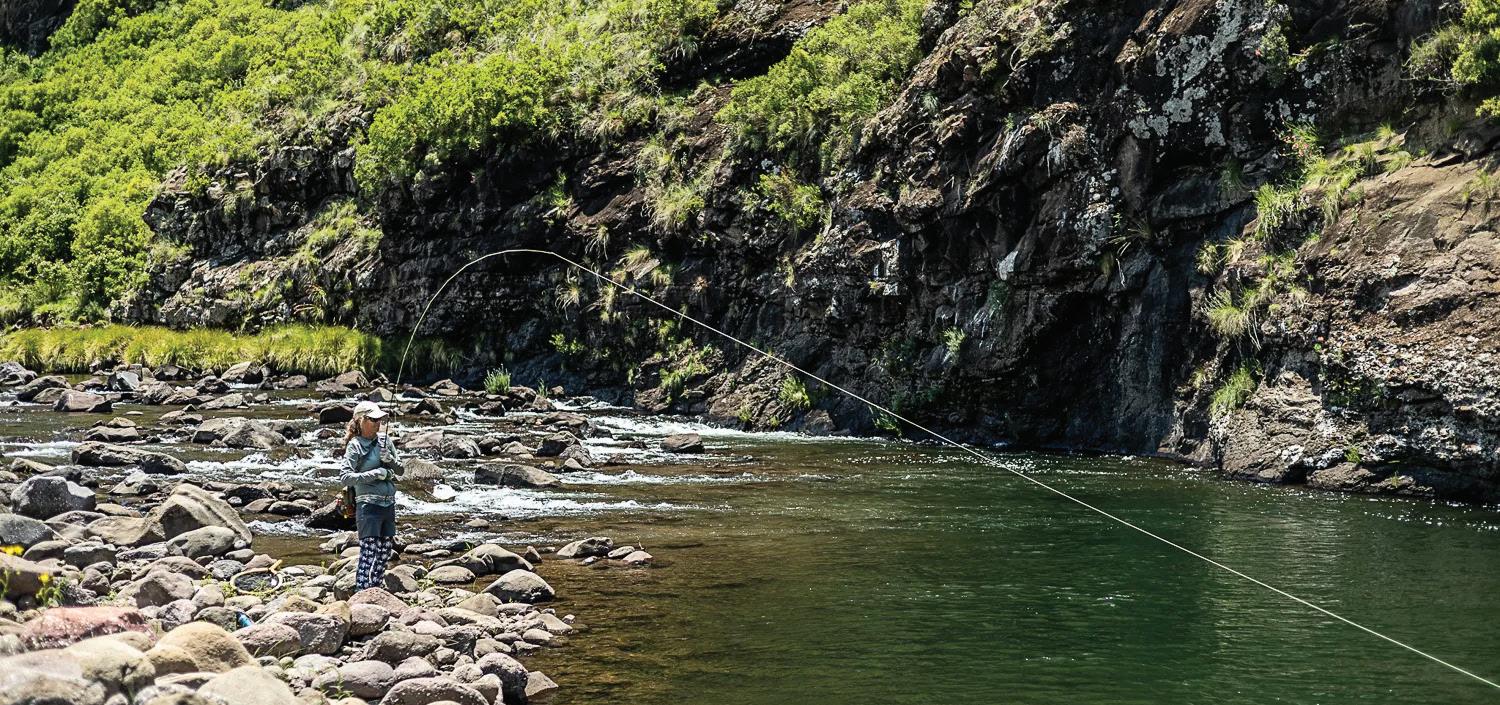
a way which is very little changed over the last century. Cattle pull single furrow ploughs to grow strips on maize on the hillside and the village is tidy and well kept. Transport for the locals is on foot or by horse and donkey with no cars in evidence. As a visiting fisher you do feel as if you have been dropped into a landscape that exists separately from the outside world and it is a real privilege to visit.
The fishing is of course why I visited. The lodge specialises in yellow fish and trout. At the time I fished, late November, yellow fish are the main target. They move from the enormous Katse dam into the Bokong River to spawn, much as salmon run from the sea to the river. It was extraordinary to see the large numbers of fish move through the pools.
They behave in a very different way from trout or salmon, rather than holding on a lie they cruise throughout the pools and move up and down the river depending on water temperature and so on.
The fishing is very technical and challenging, and extremely exciting. Generally, you fish either dry fly or very small, weighted nymphs and you will be sight casting to fish. The yellows do spook quite easily and the water is gin clear, so stealth is very important. The fish are numerous and often a good size. I fished during a period when the fishing was difficult, but the week before the fish had been really on and everyone landed multiple fish. Yellow fish over 60cms are considered noteworthy here and I saw quite a few that size in the river. These fish fight hard, much harder than
you would expect for their size, are very selective and are a worthy quarry. It is not unlike New Zealand fishing, walking quite long distances stalking fish in gin clear rivers.
The season runs from November to April, which is spring to autumn, and the trout fishing tends to be in the second half of the season. We caught some smaller trout but the larger ones are caught later in the season. Unusually, for this part of the world, you can catch both wild browns and rainbows.
The lodge normally hosts between six and eight fishers and people stay for different periods, from four days to ten days generally. The guide team are top-notch, very enthusiastic and knowledgeable and a pleasure to fish with. Although
they were all quite young, they were very professional and could not be more helpful. We were also fortunate to have Hannah from the UK who was in charge of producing delicious meals (the guides also assisted with this making it a team effort). There was a great atmosphere in camp and a palpable team spirit. This was helped by the other guests, all of whom were repeat fishers, always a good sign.
This trip is not for everyone as it is physically quite demanding, especially given that the height above sea-level leaves you gasping for breath after walking up the steep slopes sometimes! You will walk several kms a day, much of it uphill, downhill or along the rocky riverbanks. Fishing is either wet wading or fishing from the bank and is not too taxing although it is a help if you can


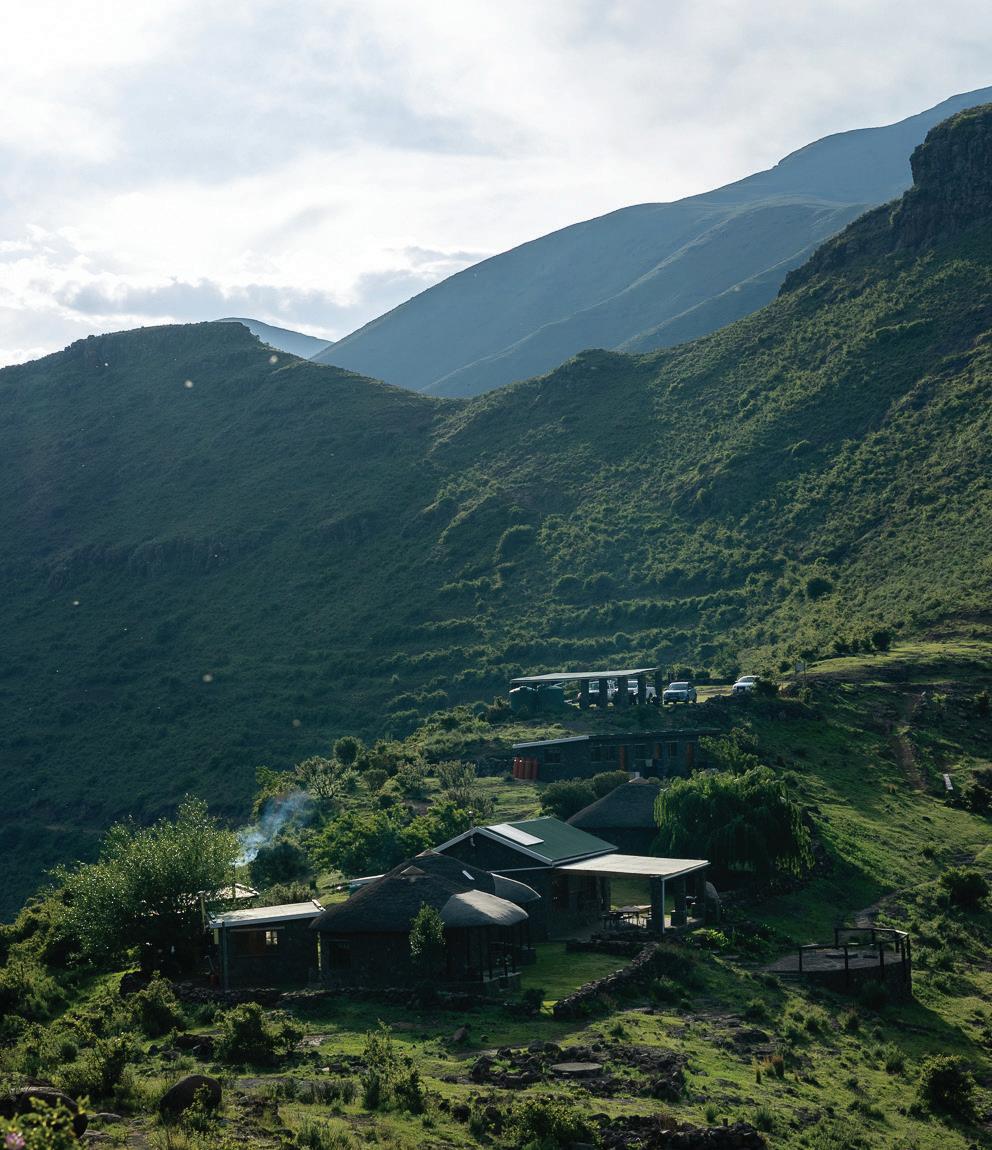
cast from a crouching position. It is also very technical; sight fishing with 4-weight rods and dry flies or nymphs requires a lot of concentration. However, it is also very rewarding fishing and I for one learnt a lot and came away feeling that I had become a more considered fisher. As someone who has fished a lot with heavier tackle for salmon or aggressive predators it was a steep learning curve to handle the light tippets with care when striking or playing fish.
I would really recommend this trip for those looking for something different. The fishing is exciting and challenging,
but this trip is about so much more. The absolutely stunning scenery, the insight into how the local people live and the whole Lesotho experience make it a unique adventure. The lodge itself was also a pleasure, with lovely touches such as large free-standing bathtubs with lots of hot water and delicious dinners eaten with everyone, staff and guests, around the large kitchen table. I would guess that many people reading this know South Africa very well but have not visited Lesotho. My advice is to have a few days at Makhangoa Community Camp on your next trip to Southern Africa and catch a few yellow fish or trout on the Bokong River.


There are multiple lodges in Southern Africa to extend your tri p.
Royal Zambezi
Great for families with lots of wildlife
Tigerfish amongst various species to target
A luxurious family owned lodge on the banks of the Lower Zambez i
Gkhui Gkhui Lodge
Luxury rooms overlooking the river
Caters for fishing and non-fishing partners
Great spot for yellowfish


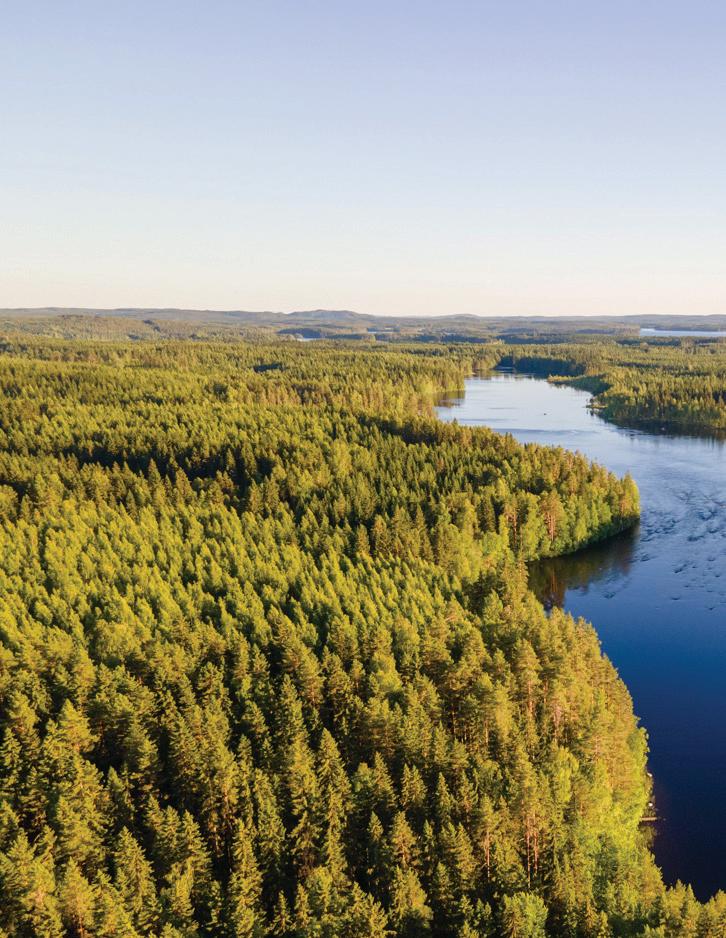
BY TARQUIN MILLINGTON-DRAKE
FIND OUT MORE

As a reader, I hope you have seen video footage of golden dorado feasting on baitfish in Bolivia because what I want to explain to you is best compared to that spectacle. But incredulously, we are talking about trout in Finland not anything so exotic as a South American jungle.
This story needs to start in 2023 in northern Finland. Some lovely Finnish guys invited me to see their lodge and fishing operations. The fishing was based around a big run of Baltic salmon along with grayling and trout. I made my way to Alta, picked up a car and headed east across the border. The lodge was quirky but lovely and the guys running it were so nice. We headed out fishing.
That evening, I had to sit them down and have a serious chat. I was gutted because they were so nice and so aware of how to run a lodge, it was perfect for clients but there was one BIG problem. The run of Baltic salmon had melted from 90,000 fish the year before to something like 7,000 this year. There simply were no fish and the reason was human damage through netting and over-fishing. Equally, the biggest grayling we caught was about three quarters of a pound. There were no trout.
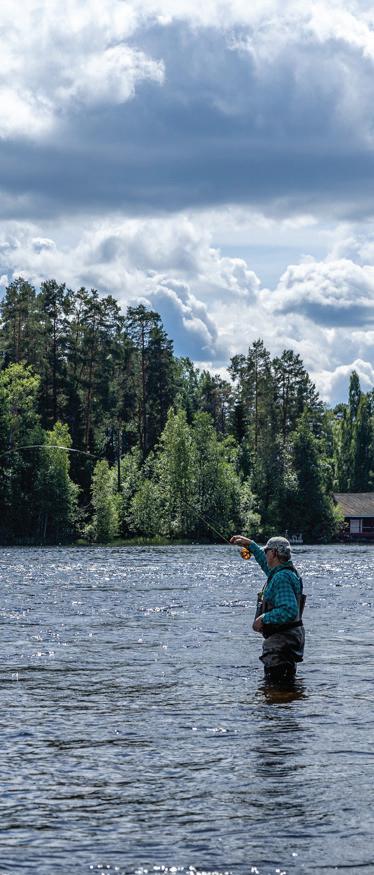
Once we got serious, they explained to me that this beautiful land of 10,000 lakes had basically been raped by overfishing and over-killing. Both the Finns and foreigners would come to Finland (particularly the north where there is a free for all and no private water) and kill all they caught on rod and line and net the rivers and lakes too. They loaded their catch into the freezers they brought with them and head home. I always imagined driving through this lake-strewn land that it was the land of milk and honey for trout and grayling – the truth is they are empty. It was shocking and I thank Elias and Toni for their honesty. They led me to this story which is even more remarkable given what I have described above.
Three and a half hours drive from Helsinki (I have to say one of the easiest and pleasurable drives I have done in a long time – it made me wonder why I was not considering moving to Finland!) lies an extraordinary fishery that I did not know existed until recently. The drive is north of Helsinki to mid-Finland, somewhere I have not been to before and it was stunning farming country with hardly any people. Up a short track through some trees, Kellankoski Lodge appears in front of you.
Built in 1923, the lodge is a beautiful traditional old building which used to be a local school now converted into a small fishing lodge. It sits on the banks of Liesvesi lake which is part of the Rautalampi water system which goes from Pielavesi some 220 kms emptying


Todd M oen's film here
into the Baltic sea at Kymijoki. It is full of pike, zander, some grayling and happily, in this particular area, some very fine trout.
The lodge speaks of 10 kms of fishing and they are not lying but the key fishing is in the rapids of the system and those rapids probably measure closer to 3 or 4 kilometres. The rapids (20 to 50 metres wide) are key to this fishery and so are the ‘baitfish’ which consist of bleak, small roach and vendace. Bleak have an elongated, flat body with a long anal fin and pointed heads with a relatively small upturned mouth. They are shiny silver in colour and have a dark green/black back and fins that are pointed and colourless. Their maximum length is approximately 20cm. They look like tiny tarpon. The roach is also a small fish, often reaching no more than about 35 cms. Its body has a bluish-silvery colour and becomes white at the belly. The fins are red. Young roach have a slender build; older specimens
acquire a higher and broader body shape. Vendace are part of the whitefish family and also small up to about 20 cms and equally shiny and silver. Young perch also form part of the ‘run’.
Commencing in the spring, these small silver fish begin to run in their hundreds of thousands (sometimes when you wade the bottom of the river parts as you push the baitfish out of the way) between the lakes of this 220+ kms Rautalampi system and through the rapids; the trout are following them. The trout hide out in the fastest possible water (think white water) ready to ambush them and when they do, the action can be a real spectacle with the trout flying out of the water time and again as they pound the baitfish, often moving downstream as they do so. I have certainly never seen trout behave like this anywhere and the spectacle is akin to dorado feeding. Their takes are more like that of an Atlantic salmon taking a


• In May and early June, streamers, and of course skaters, are best. In early summer, high water levels may present challenges but keep in mind that big water can mean big fish.
• Bring caddis flies too. Do not forget strong tippet for streamers, min .35 mm, about 20lbs.
• 7 to 8 weight rods for streamers and 6 weight for small flies. A wading stick is valuable.
• In July, the best time to catch fish is the reduced daylight hours. On summer evenings, it is a good idea to look what the birds are doing. Bring streamers, caddis flies and pupaes. Don’t forget strong tippet for streamers, min .30 -.35mm, about 20lbs.
• 7 to 8 weight rods for streamers and 6 weight for small flies. A wading stick is valuable.
• In August, when water levels are low, pupae imitations and other tiny flies are best in the evening. Streamers and skaters still work. Bring smaller streamers, caddis flies and pupaes. Don’t forget strong tippet for streamers, min .30 –.35mm, about 20lbs.
• 7 weight rods for streamers and 5 to 6 weight for smaller flies.
• Chest waders are important, and a wading stick, and it is important to bring insect repellent. The lodge is casual and relaxed.
Contact Tarquin M illington-Drake
sunray. So how does Kellankoski Lodge set about fishing for the trout?
In an ideal world, they would like to entice you to fish for pike or zander during one of the four-hour fishing sessions to both have you enjoy those species but also to keep pressure on the trout to a minimum though the trout move in and out of the lakes so what trout might be in the rapids one day may be totally different the next. There are lots of pike up to 20 lbs so some time fishing for them in the crystal-clear lakes is certainly not to be sniffed at, in fact, it is really good fun. We did not get around to fishing for the zander. They divide their private water into beats based on the rapids with differing numbers of rods on each beat depending on their carrying capacity for number of rods and the water height as well as wading capability. On some beats there are platforms to fish from as well.
There are opportunities to fish a caddis upstream or skated, particularly later in the season but the focus is on baitfish imitations and skated flies. They use drift boats for those that struggle to wade, and these can access all parts of the rapids as required. The wading can be tough because of the uneven bottom and the power of the water so boats are preferable. Guides will advise guests to fish downstream and across like salmon fishing but upstream as well striping fast. Variable speeds and style of stripping are advised. As I have commented, the trout hit the fly at speed, sometimes with a hammering splash, other times the entire fish will come flying out of the water. These fish take their hunting very seriously!
The lodge would like guests to bring a 7-weight, I used a 5-weight, and it was
hard work both in terms of casting largish flies and when hooking a fish. The trout are extremely strong (I was spooled by one fish and never saw it!) because of the fast water but they big wild fish too. I would make your choice based on your skill level when casting decent sized flies. Most of my fish took 20-minutes or more to land with many nervous moments over being broken in the wild water. One lands about every tenth fish that tries to take your fly. The cause is not angler error but the chaotic way the trout attack the fly, they are on and off almost before you can react. Suddenly there is a huge explosion, a massive pull and it is all over before one has done anything!
This is not classic trout fishing to supping wild brownies. This is fishing for trout like one has never done before because one has never seen trout behave the way they do. Consequently, it is not for everyone, but I have to say, it is very cool and truly unique, and the trout are beautiful wild specimens with red spots. The differ in colour depending on how recently they

came out of lake, the more silver, the more recently they have dropped from the lakes. I caught fish from about 3.5 to 7lbs but bigger are landed fairly regularly.
Your hosts are Jani and Titta Himanko. Titta has taken firm control of the lodge and takes huge pride in delivering a comfortable experience for guests. She was previously an arts and craft teacher, and she still works with counselling young adults. Jani has more than twenty years of experience in fishing tourism and the fishing tackle industry. He is a member of the Finnish Fishing Hall of Fame which Jani humbly says is very small! Some may recognise him from TV shows, videos and pages in both Finnish and foreign anglers’ magazines and videos. Jani continues to submit articles to Metsästys ja Kalastus – and PohjolanPerhokalastaja, two Finnish magazines focusing on hunting and fishing. Jani has been a professional fishing guide since 2001. He and his team of guides have whitewater experience and carry the usual First Aid qualifications.
Converting the lodge has been a work in progress and great things are planned for cabins overlooking the lake in the future. The lodge can take up to ten rods depending on how many are sharing rooms/guides etc. There is a fine sauna overlooking the lake, always the number one priority for any lodge in Finland! There is work that needs to be done this winter such as a proper wader drying room, improvements to the bug screens on the windows and evolving the large sitting/dining room (which was the main teaching room) into more of a lodge atmosphere.

But Jani is already sending me photos of work in progress in that regard. A typical day will start with breakfast at 10 am (you will see why), relax after breakfast or maybe go pike fishing. Lunch is at 1.30 pm and dinner at 6.30. Fishing hours are between lunch and dinner and then a full session after dinner until midnight or even later. The best fishing tends to be when the sun is off the water, that is when the real hunting begins, and one can see when the fish are ‘on’ because they start to splash and fly out of the water.
In terms of travel, we think the easiest and most interesting way to get there is to rent a car from Helsinki airport and do the very easy drive but there are flights to Jyväskylä Airport, which is 56 km away. Alternatively a train to Jyväskylä train station is a good option and the trains in Finland work very well. Having a car gives you that extra bit of freedom too. The nearest village, Konnevesi, is 10-minutes away, the nearest city is Jyväskylä about 56 kms away. The



nearest doctor is 10 minutes away, hospital 55 minutes away.
For those not fishing or wanting to mix their fishing with other things to do, Etelä-Konnevesi National Park and other hiking tracks are also nearby. There is also kayaking, river rafting, berry picking, mushrooming, horse riding (Icelandic), baking finnish pastry or buns with Titta or her daughters and just having a look around this beautiful area. If you need a break from big trout, you can always dry fly for bleak with tiny dry flies. They will hardly bend your 5-weight but it is great fun and Jani sits there incredulous that anyone should find it entertaining!
In summary, the negatives to this fishery are there are mosquitoes, and I worry that
sometimes there are too many rods on the water. I would not be telling the truth if I did not admit that a part of me wishes I could be casting upstream to these huge, wild, stunning fish as they sipped small dries off the top. But the negatives stop there. Jani and Titta are truly lovely people and nothing is too much trouble for them. The fishing is in a beautiful area which is so peaceful one cannot help but relax into the routine under the midnight sun. The trout and the way you fish for them, in my book, are truly unique and for that alone, this trip is worth it. They really are special trout, and the takes and behaviour must be seen to be believed. When you combine this with the excellent value to the trip (€4,480 for 7 nights/6 days shared room/guide) and the ease of travel, this experience should be on everyone’s list.



